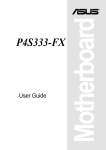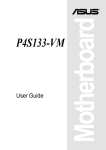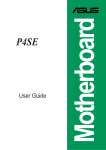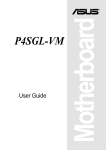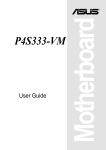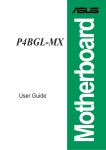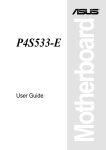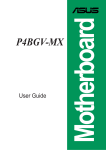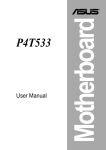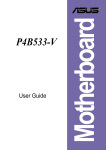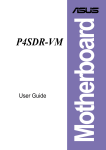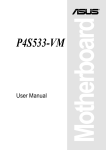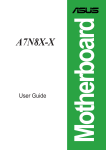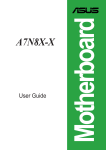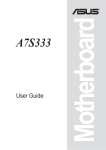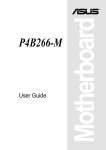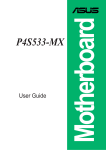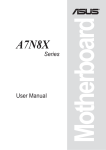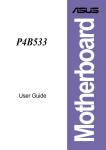Download Asus P4S133 User guide
Transcript
P4S133 User Guide Motherboard ® Checklist P4S133 E1025 April 2002 Copyright © 2002 ASUSTeK COMPUTER INC. All Rights Reserved. No part of this manual, including the products and software described in it, may be reproduced, transmitted, transcribed, stored in a retrieval system, or translated into any language in any form or by any means, except documentation kept by the purchaser for backup purposes, without the express written permission of ASUSTeK COMPUTER INC. (“ASUS”). Product warranty or service will not be extended if: (1) the product is repaired, modified or altered, unless such repair, modification of alteration is authorized in writing by ASUS; or (2) the serial number of the product is defaced or missing. Products and corporate names appearing in this manual may or may not be registered trademarks or copyrights of their respective companies, and are used only for identification or explanation and to the owners’ benefit, without intent to infringe. The product name and revision number are both printed on the product itself. Manual revisions are released for each product design represented by the digit before and after the period of the manual revision number. Manual updates are represented by the third digit in the manual revision number. For previous or updated manuals, BIOS, drivers, or product release information, contact ASUS at: http://www.asus.com or through any of the means indicated on the following page. ASUS PROVIDES THIS MANUAL “AS IS” WITHOUT WARRANTY OF ANY KIND, EITHER EXPRESS OR IMPLIED, INCLUDING BUT NOT LIMITED TO THE IMPLIED WARRANTIES OR CONDITIONS OF MERCHANTABILITY OR FITNESS FOR A PARTICULAR PURPOSE. IN NO EVENT SHALL ASUS, ITS DIRECTORS, OFFICERS, EMPLOYEES OR AGENTS BE LIABLE FOR ANY INDIRECT, SPECIAL, INCIDENTAL, OR CONSEQUENTIAL DAMAGES (INCLUDING DAMAGES FOR LOSS OF PROFITS, LOSS OF BUSINESS, LOSS OF USE OR DATA, INTERRUPTION OF BUSINESS AND THE LIKE), EVEN IF ASUS HAS BEEN ADVISED OF THE POSSIBILITY OF SUCH DAMAGES ARISING FROM ANY DEFECT OR ERROR IN THIS MANUAL OR PRODUCT. SPECIFICATIONS AND INFORMATION CONTAINED IN THIS MANUAL ARE FURNISHED FOR INFORMATIONAL USE ONLY, AND ARE SUBJECT TO CHANGE AT ANY TIME WITHOUT NOTICE, AND SHOULD NOT BE CONSTRUED AS A COMMITMENT BY ASUS. ASUS ASSUMES NO RESPONSIBILITY OR LIABILITY FOR ANY ERRORS OR INACCURACIES THAT MAY APPEAR IN THIS MANUAL, INCLUDING THE PRODUCTS AND SOFTWARE DESCRIBED IN IT. ii About this guide Features This user manual contains complete information for installing the ASUS P4S133 motherboard. How this guide is organized • • • • • • • Chapter 1: Product introduction. A summary of product features and special attributes of new technologies. Chapter 2: Hardware information. A list of hardware setup procedures and descriptions of all jumpers and connectors on the motherboard. Chapter 3: Powering up. Describes the power up sequence with information on BIOS beep codes. Chapter 4: BIOS setup. How to change system settings using onboard BIOS firmware. Detailed descriptions of the BIOS parameters are supplied. Chapter 5: Software support. A summary of contents on the motherboard support CD ROM. Appendix and Glossary. Optional components and technical definitions. Index Conventions used in this guide To make sure that you perform set-up tasks properly, take note of the following symbols used throughout this manual. WARNING! Information to prevent injury to yourself. CAUTION! Information to prevent damage to the components. IMPORTANT! Information that you MUST follow to complete a task. NOTE! Tips and helpful information. iii Contents Safeguards About this guide .............................................................................. iii How this guide is organized .................................................... iii Conventions used in this guide ............................................... iii Safety information ........................................................................... vi FCC/CDC statements .................................................................... vii ASUS contact information ............................................................. viii Chapter 1: Product introduction ............................................. 1 Welcome! ........................................................................................ 1.1 Package contents .................................................................. 1.2 Core Specifications ................................................................ 1.3 Special Features .................................................................... 1.4 Motherboard Components ...................................................... 1.4.1 Component Locations ................................................ 1 1 2 3 4 5 Chapter 2: Hardware information ............................................ 7 2.1 2.2 2.3 2.4 2.5 2.6 2.7 iv Motherboard installation ......................................................... 7 2.1.1 Placement direction ................................................... 7 2.1.2 Screw holes ............................................................... 7 Motherboard layout ................................................................ 8 Before you proceed ................................................................ 9 Central Processing Unit (CPU) ............................................. 10 2.4.1 Overview ..................................................................10 2.4.2 Installing the CPU ..................................................... 11 2.4.3 Installing the heatsink and fan .................................. 13 2.4.4 Connecting the CPU fan cable ................................. 15 System memory ....................................................................16 2.5.1 Overview ..................................................................16 2.5.2 General DIMM Notes ............................................... 16 2.5.3 Memory configurations ............................................ 17 2.5.3 Installing a DIMM ..................................................... 18 2.5.4 Removing a DIMM ................................................... 19 Expansion slots .....................................................................20 2.6.1 Installing an expansion card ..................................... 20 2.6.2 Configuring an expansion card ................................ 21 2.6.3 PCI slots ...................................................................22 2.6.4 AGP slot ...................................................................22 Jumpers ................................................................................23 Contents 2.8 Connectors ...........................................................................29 Chapter 3: Powering up ......................................................... 41 3.1 3.2 Starting up for the first time................................................... 41 Powering off the computer .................................................... 42 Chapter 4: BIOS setup ........................................................... 43 4.1 4.2 4.3 4.4 4.5 4.6 4.7 Managing and updating your BIOS ....................................... 43 4.1.1 Using the computer system for the first time ............ 43 4.1.2 Updating BIOS procedures ...................................... 45 BIOS Setup program .............................................................47 4.2.1 BIOS menu bar .........................................................48 4.2.2 Legend bar ...............................................................48 Main menu ............................................................................50 4.3.1 Primary & Secondary Master/Slave ......................... 51 4.3.2 Keyboard Features .................................................. 55 Advanced Menu ....................................................................57 4.4.1 Chip Configuration ................................................... 59 4.4.2 I/O Device Configuration .......................................... 62 4.4.3 PCI Configuration .................................................... 64 Power Menu ..........................................................................67 4.5.1 Power Up Control .................................................... 69 4.5.2 Hardware Monitor .................................................... 71 Boot Menu ............................................................................72 Exit Menu ..............................................................................74 Chapter 5: Software support ................................................. 77 5.1 5.2 5.3 5.4 5.5 5.6 5.7 Install an operating system ................................................... 77 Support CD information .........................................................77 P4S133 Motherboard Support CD ........................................ 78 ASUS PC Probe ....................................................................80 ASUS Live Update ................................................................85 3Deep Color Tuner ................................................................86 ITE GSM Editor .....................................................................88 Glossary .................................................................................. 93 Index ........................................................................................ 97 v Safety information Electrical safety • To prevent electrical shock hazard, disconnect the power cable from the electrical outlet before relocating the system. • When adding or removing devices to or from the system, ensure that the power cables for the devices are unplugged before the signal cables are connected. Disconnect all power cables from the existing system before you add a device. • Before connecting or removing signal cables from the motherboard, ensure that all power cables are unplugged. • Seek professional assistance before using an adpater or extension cord. These devices could interrupt the grounding circuit. • Make sure that your power supply is set to the voltage available in your area. • If the power supply is broken, contact a qualified service technician or your retailer. Operational safety • Before installing the motherboard and adding new devices, carefully read all the manuals that came with the package. • Before use ensure all cables are correctly connected and the power cables are not damaged. If you detect any damage, contact the dealer immediately. • To avoid short circuits, keep paper clips, screws, and staples away from connectors, slots, sockets and circuitry. • Avoid dust, humidity, and temperature extremes. Do not place the product in any area where it may become wet. • Mount the motherboard inside a standard PC enclosure. • If you encounter technical problems with the product, contact a qualified service technician or the dealer. vi FCC/CDC statements Federal Communications Commission Statement This device complies with FCC Rules Part 15. Operation is subject to the following two conditions: • • This device may not cause harmful interference, and This device must accept any interference received including interference that may cause undesired operation. This equipment has been tested and found to comply with the limits for a Class B digital device, pursuant to Part 15 of the FCC Rules. These limits are designed to provide reasonable protection against harmful interference in a residential installation. This equipment generates, uses and can radiate radio frequency energy and, if not installed and used in accordance with manufacturer’s instructions, may cause harmful interference to radio communications. However, there is no guarantee that interference will not occur in a particular installation. If this equipment does cause harmful interference to radio or television reception, which can be determined by turning the equipment off and on, the user is encouraged to try to correct the interference by one or more of the following measures: • Reorient or relocate the receiving antenna. • Increase the separation between the equipment and receiver. • Connect the equipment to an outlet on a circuit different from that to which the receiver is connected. • Consult the dealer or an experienced radio/TV technician for help. The use of shielded cables for connection of the monitor to the graphics card is required to assure compliance with FCC regulations. Changes or modifications to this unit not expressly approved by the party responsible for compliance could void the user’s authority to operate this equipment. Canadian Department of Communications Statement This digital apparatus does not exceed the Class B limits for radio noise emissions from digital apparatus set out in the Radio Interference Regulations of the Canadian Department of Communications. This class B digital apparatus complies with Canadian ICES-003. vii ASUS contact information ASUSTeK COMPUTER INC. (Asia-Pacific) Marketing Address: Telephone: Fax: Email: 150 Li-Te Road, Peitou, Taipei, Taiwan 112 +886-2-2894-3447 +886-2-2894-3449 [email protected] Technical Support Tel (English): Tel (Chinese): Fax: Email: Newsgroup: WWW: FTP: +886-2-2890-7123 +886-2-2890-7113 +886-2-2890-7698 [email protected] cscnews.asus.com.tw www.asus.com.tw ftp.asus.com.tw/pub/ASUS ASUS COMPUTER INTERNATIONAL (America) Marketing Address: Fax: Email: 6737 Mowry Avenue, Mowry Business Center, Building 2 Newark, CA 94560, USA +1-510-608-4555 [email protected] Technical Support Fax: BBS: Email: WWW: FTP: +1-510-608-4555 +1-510-739-3774 [email protected] www.asus.com ftp.asus.com/pub/ASUS ASUS COMPUTER GmbH (Europe) Marketing Address: Fax: Email: Harkortstr. 25, 40880 Ratingen, BRD, Germany +49-2102-442066 [email protected] (for marketing requests only) Technical Support Hotline: Fax: Support (Email): WWW: FTP: viii MB/Others: +49-2102-9599-0 Notebook: +49-2102-9599-10 +49-2102-9599-11 www.asuscom.de/de/support (for online support) www.asuscom.de ftp.asuscom.de/pub/ASUSCOM Chapter 1 Product introduction ASUS P4S133 motherboard Welcome! Thank you for buying the ASUS® P4S133 motherboard! The ASUS P4S133 motherboard delivers a host of new features to ensure long-lasting, superlative performance. The ASUS® P4S133 motherboard is the prime choice for home PCs and workstations. The P4S133 incorporates the Intel® Pentium® 4 Processor coupled with the SiS 645 chipset to set a new benchmark for an effective desktop platform solution. ~ CPU Thermal Protection ~ Up to 3GB of system memory of PC100/133 SDRAM ~ High-resolution graphics via an AGP 4X slot ~ Digital Audio Interface for 3D sound ~ Realtek™ LAN Controller onboard ~ ASUS Post Reporter™ onboard ~ Two USB ports plus one header for two more Before installing the motherboard, check the items in your package: 1.1 Package contents Check your P4S133 package for the following items. ASUS P4S133 motherboard (ATX form factor: 12-in x 8.6-in) ASUS P4S133 support CD ASUS 2-port USB 1.1 module 80-conductor ribbon cable for UltraDMA/33/66/100 IDE drives 40-conductor IDE cable Ribbon cable for a 3.5-inch floppy drive Bag of extra jumper caps User Guide If any of the above items is damaged or missing, contact your retailer. ASUS P4S133 motherboard user guide 1 1.2 Core Specifications The P4S133 motherboard is designed and assembled according to the highest standards. This ASUS motherboard represents the latest advances and offers users the finest componentry available today... Latest P4 Processor Technology: Intel Pentium 4 Socket 478 Northwood Processor. The Pentium 4 processor utilizes the advanced 0.18 micron processor core in FC-PGA2 package for a 2.0GHz frequency, while the Northwood processor uses the 0.13 micron processor core with 512KB L2 cache for up to a speedy 2.2+GHz frequency. The P4 offers optimized performance for audio, video, and Internet applications. North Bridge Chipset: the SiS® 645 supports AGP 4X/2X mode, 400MHz Front Side Bus, and the fastest 133/100MHz memory bus. South Bridge Chipset: the SiS® 961 integrated peripheral controller supports UltraDMA/100/66/33 for burst mode data transfer rates of up to 100MB/ sec, and USB controller with three root hubs for six USB ports. PC133 SDRAM: Equipped with three Dual Inline Memory Module (DIMM) sockets to support Intel PC133-compliant (8, 16, 32, 64, 128, 256, 512, or 1024MB) SDRAM up to 3GB. UltraDMA/100 Support: Comes with an onboard PCI Bus Master IDE controller with two connectors that support four IDE devices on two channels. Supports UltraDMA100/66/33, PIO Modes 3 & 4, Bus Master IDE DMA Mode 2, and Enhanced IDE devices, such as DVD-ROM, CDROM, CD-R/RW, LS-120, and Tape Backup drives. Multi-I/O Chipset: Offers complete support for a variety of I/O functions. Provides two high-speed UART compatible serial ports and one parallel port with EPP and ECP capabilities. UART2 can also be directed from COM2 to the Infrared Module for wireless connections. The Super I/O controller supports a floppy disk drive, PS/2 keyboard, and PS/2 mouse. Smart BIOS: 2Mb firmware enables Vcore and CPU/DDR SDRAM frequency adjustments, boot block write protection, and HD/SCSI/MO/ZIP/CD/Floppy boot selection. Concurrent PCI: Concurrent PCI allows multiple PCI transfers from PCI master busses to the memory and processor. Expansion: One AGP 4X, four USB ports, five PCI slots, SPDIF digital audio, iPanel, front audio panel, SMB, smart card, infrared. Connections: Parallel, PS/2 mouse, PS/2 keyboard, 2 USB, RJ45, Microphone, Line In Jack, Line Out Jack, Standard ATX power. 2 Chapter 1: Product introduction 1.3 Special Features Easy Overclocking • Quickly adjust CPU frequency multiples with BIOS in JumperFree™ Mode • Adjustable FSB/MEM/PCI frequency ratio • Stepless Frequency Selection (SFS) for fine-tuning system bus frequency from at 1MHz increments • Optimal system performance available with BIOS built-in Turbo Mode • Adjustable Vcore Voltage and VIO • Alternatively, easy-to-use DIP switches permit manual adjustment of the processor external/internal frequency settings Digital Audio: On audio models, a digital audio connector is onboard to accommodate the Sony/Philips Digital Interface (S/PDIF) Out module, which supports coaxial and fiber interfaces. Experience 5.1-channel surround sound and enhanced 3D audio while playing DVDs and computer games. Smart Card Reader Support: A special connector for the Smart Card Reader comes onboard to support the cutting-edge technology for increased security in authenticating online transactions, editing IC-based information. Temperature, Fan and Voltage Monitoring: CPU temperature is monitored by the ASUS ASIC through the CPU’s internal thermal diode to prevent overheating and damage. All system fans are monitored for RPM and failure. System voltage levels are monitored to ensure stable voltage to critical motherboard components. ACPI Ready: Advanced Configuration Power Interface (ACPI) provides more Energy Saving Features for operating systems that support OS Direct Power Management (OSPM). Onboard LAN (Optional): The motherboard incorporates the Realtek PHY RTL8201 chip to support 10BASE-T/100BASE-TX Fast Ethernet networking. Auto Fan Off: The system fans powers off automatically even in sleep mode. Dual Function Power Button: Push the power button for less than 4 seconds when the system is operating places the system into sleep or soft-off modes, depending on the BIOS or OS setting. If the power button is pressed for more than 4 seconds, the system enters the soft-off mode regardless of the BIOS setting. ASUS P4S133 motherboard user guide 3 1.4 Motherboard Components Before installing the P4S133 motherboard, take time to familiarize yourself with its configuration: understanding the motherboard makes upgrading easy. Sufficient knowledge of specifications prevents accidental damage. Processor Support Chipsets Main Memory Expansion Slots System I/O Hardware Monitoring Special Feature Network Feature Audio Features Power Form Factor 4 Location Socket 478 for Intel P4 Processors ............................. 2 Feature Setting DIP Switches ....................................... 10 SiS® 645 North Bridge ..................................................... 3 2Mbit Programmable Flash EEPROM .......................... 17 SiS® 961 South Bridge .................................................... 9 Multi-I/O Controller ........................................................ 16 3 SDRAM DIMM Sockets (3GB) ..................................... 5 5 PCI Slots .................................................................... 22 1 Accelerated Graphics Port (AGP) 4X Slot .................. 25 1 Floppy Disk Drive Connector ....................................... 7 2 IDE Connectors (UltraDMA/100 Support) .................... 8 Smart Card Connector (Optional) ................................. 11 1 Infrared Connector ..................................................... 12 1 ASUS iPanel Connector (Optional) ............................ 13 1 System Panel Connector ........................................... 14 USB Headers (USB1, USB2) ........................................ 18 Modem Connector ......................................................... 20 1 Parallel Port ................................................................ 28 2 Serial Ports (COM1/COM2) ....................................... 33 USB Connectors (Port 0/1 & 2/3) ................................. 34 1 PS/2 Mouse Connector ................................. (green) 26 1 PS/2 Keyboard Connector .......................... (purple) 35 System Voltage Monitor (integrated in ASUS ASIC) ..... 15 Onboard LED ................................................................ 19 LAN Controller ............................................................... 24 1 RJ45 Connector ......................................................... 27 (on audio models only) Audio Connectors .......................................................... 23 Audio Controller Chipset ............................................... 21 1 Game / MIDI Connector ............................................. 29 1 Line Out Connector ......................................... (lime) 32 1 Line In Connector ................................... (light blue) 31 1 Microphone Connector .................................... (pink) 30 ATX 12V Aux Power Supply Connector .......................... 1 ATX Power Supply Connector ......................................... 4 ATX 12V Power Supply Connector ................................. 6 ATX ® ™ Chapter 1: Product introduction 1.4.1 Component Locations 1 2 3 4 5 6 7 8 25 24 23 9 10 22 21 11 12 20 13 19 26 35 27 34 18 28 33 ASUS P4S133 motherboard user guide 17 16 15 14 29 32 31 30 5 Chapter 2 Hardware information ASUS P4S133 motherboard 2.1 Motherboard installation Before you install the motherboard, study the configuration of your chassis to ensure that the motherboard fits into it. The P4S133 uses the ATX form factor that measures 30.5 cm (12.0 in) x 21.9 cm (8.6 in), a standard fit for most chassis. Make sure to unplug the power cord before installing or removing the motherboard. Failure to do so may cause you physical injury and damage motherboard components. 2.1.1 Placement direction When installing the motherboard, make sure that you place it into the chassis in the correct orientation. The edge with external ports goes to the rear part of the chassis. Refer to the image below. 2.1.2 Screw holes Place six (6) screws into the holes indicated by circles to secure the motherboard to the chassis. Do not overtighten the screws! Doing so may damage the motherboard. Place this side towards the rear of the chassis ASUS P4S133 motherboard user guide 7 2.2 Motherboard layout Bottom: USBV1 PS/2KBMS T: Mouse B: Keyboard KBPWR1 21.9cm (8.6in) AUX12V1 ATX Power Connector PWRFAN1 VEN1 Top: SiS645 HOST/ Memory Controller Line Out Line In 2 3 4 5 FLOPPY1 0 1 30.5cm (12.0in) GAME_AUDIO COM2 DIMM Socket 3 (72-bit, 168-pin module) ATX12V1 CPUFAN1 DIMM Socket 2 (72-bit, 168-pin module) PARALLEL PORT COM1 DIMM Socket 1 (72-bit, 168-pin module) Socket 478 USB1 RJ-45 USB2 Chip CD1 SiS961 MuTLOL Media I/O PCI1 ALIN1 CMI8738 6CH Audio Controller P4S133 C-Media JEN1 PWRTMP1 PCI2 IAPANEL1 AUX1 BCS1 BCS2 IDE1 Accelerated Graphics Port AGP DSW1 LAN PHY IDE2 Mic In PC3 ® CLRCMOS1 CR2032 3V Lithium Cell CMOS Power SMB1 SMARTCON1 IR1 CHASSIS1 PCI4 SPDIF1 Super I/O LED1 2Mbit Firmware Hub PCI5 MODEM1 USB2 USB1 ASUS ASIC with Hardware Monitor CHASFAN1 USBV2 USBV3 AFPANEL1 IDELED1 PANEL1 The audio and LAN features are optional. These components are grayed out in the above motherboard layout. 8 Chapter 2: Hardware information 2.3 Before you proceed Take note of the following precautions before you install motherboard components or change any motherboard settings. 1. Unplug the power cord from the wall socket before touching any component. 2. Use a grounded wrist strap or touch a safely grounded object or to a metal object, such as the power supply case, before handling components to avoid damaging them due to static electricity. 3. Hold components by the edges and do not to touch the ICs on them. 4. Whenever you uninstall any component, place it on a grounded antistatic pad or in the bag that came with the component. 5. Before you install or remove any component, ensure that the ATX power supply is switched off or the power cord is detached from the power supply. Failure to do so may cause severe damage to the motherboard, peripherals, and/or components. ASUS P4S133 motherboard user guide 9 2.4 Central Processing Unit (CPU) 2.4.1 Overview The motherboard comes with a surface mount 478-pin Zero Insertion Force (ZIF) socket. This socket is specifically designed for the Intel® Pentium® 4 478/Northwood Processor. The Intel Pentium 4 Processor in the 478-pin package uses the Flip-Chip Pin Grid Array 2 (FC-PGA2) package technology, and includes the Intel® NetBurst™ micro-architecture. The Intel NetBurst micro-architecture features the hyper-pipelined technology, rapid execution engine, 400MHz system bus, and execution trace cache. Together, these attributes improve system performance by allowing higher processor frequencies, faster execution of integer instructions, and a data transfer rate of 3.2GB/s. Gold Mark Note in the illustration that the CPU has a gold triangular mark on one corner. This mark indicates the processor Pin 1 that should match a specific corner of the CPU socket. Incorrect installation of the CPU into the socket may bend the pins and severely damage the CPU! 10 Chapter 2: Hardware information 2.4.2 Installing the CPU Follow these steps to install a CPU. 1. Locate the 478-pin ZIF socket on the motherboard. 2. Unlock the socket by pressing the lever sideways, then lift it up to a 90°-100° angle. Socket Lever 90 - 100 Make sure that the socket lever is lifted up to 90°-100° angle, otherwise the CPU does not fit in completely. ASUS P4S133 motherboard user guide 11 3. Position the CPU above the socket such that its marked corner matches the base of the socket lever. 4. Carefully insert the CPU into the socket until it fits in place. The CPU fits only in one correct orientation. DO NOT force the CPU into the socket to prevent bending the pins and damaging the CPU! Gold Mark 5. When the CPU is in place, press it firmly on the socket while you push down the socket lever to secure the CPU. The lever clicks on the side tab to indicate that it is locked. 12 Chapter 2: Hardware information 2.4.3 Installing the heatsink and fan The Intel® Pentium® 4 478/Northwood Processor requires a specially designed heatsink and fan assembly to ensure optimum thermal condition and performance. When you buy a boxed Intel Pentium 4 478/Northwood Processor, the package includes the heatsink, fan, and retention mechanism. In case you buy a CPU separately, make sure that you use only Intel certified heatsink and fan. Follow these steps to install the CPU heatsink and fan. 1. Place the heatsink on top of the installed CPU, making sure that the heatsink fits properly on the retention module base. The retention module base is already installed on the motherboard upon purchase. You do not have to remove the retention module base when installing the CPU or installing other motherboard components. CPU Heatsink Retention Module Base Your boxed Intel Pentium 4 478/Northwood Processor package should come with installation instructions for the CPU, heatsink, and the retention mechanism. If the instructions in this section do not match the CPU documentation, follow the latter. ASUS P4S133 motherboard user guide 13 2. Position the fan with the retention mechanism on top of the heatsink. Align and snap the four hooks of the retention mechanism to the holes on each corner of the module base. Make sure that the fan and retention mechanism assembly perfectly fits the heatsink and module base, otherwise you cannot snap the hooks into the holes. Retention Hole Retention Lock Retention Hook Snapped to the Retention Hole Keep the retention locks lifted upward while fitting the retention mechanism to the module base. 14 Chapter 2: Hardware information 3. Push down the locks on the retention mechanism to secure the heatsink and fan to the module base. When secure, the retention locks should point to opposite directions. 2.4.4 Connecting the CPU fan cable When the fan, heatsink, and the retention mechanism are in place, connect the CPU fan cable to the connector on the motherboard labeled CPUFAN1. CPU Fan Connector (CPUFAN1) Don’t forget to connect the CPU fan connector! Hardware monitoring errors may occur if you fail to plug this connector. ASUS P4S133 motherboard user guide 15 2.5 System memory 2.5.1 Overview This motherboard uses only Dual Inline Memory Modules (DIMMs). Sockets are available for 3.3Volt (power level) unbuffered Synchronous Dynamic Random Access Memory (SDRAM) of 16, 32, 64, 128MB, 256, 512 or 1024MB to form a memory size between 16MB and 3GB. One side (with memory chips) of the DIMM takes up one row on the motherboard. Memory speed setup is recommended through Configure SDRAM Timing by SPD (see 4.4.2 Advanced Chipset Setup). Install memory in any combination as follows: IMPORTANT: • For optimum signal integrity, inserting the DIMMs in the following order is recommended: DIMM3, DIMM2, DIMM1 • SDRAMs used must be compatible with the current PC133/PC100 SDRAM specification. • DO NOT mix SDRAMs with VC SDRAMs. Location 168-pin DIMM Total Memory DIMM1 (Rows 0&1) SDRAM 16, 32, 64, 128, 256, 512, 1024MB x1 DIMM2 (Rows 2&3) SDRAM 16, 32, 64, 128, 256, 512, 1024MB x1 DIMM3 (Rows 4&5) SDRAM 16, 32, 64, 128, 256, 512, 1024MB x1 Total System Memory (Max 3GB) = 2.5.2 General DIMM Notes • • • • • 16 This motherboard supports SPD (Serial Presence Detect) DIMMs. This is the memory of choice for best performance vs. stability. This motherboard does NOT support registered memory. SDRAM chips are generally thinner with higher pin density than EDO (Extended Data Output) chips. BIOS shows SDRAM memory on bootup screen. Single-sided DIMMs come in 16, 32, 64,128, 256, 512MB; doublesided come in 32, 64, 128, 256, 512, 1024MB. Chapter 2: Hardware information 2.5.3 Memory configurations Insert the module(s) as shown. Because the number of pins are different on either side of the breaks, the module will only fit in the orientation shown. DIMM modules are longer and have different pin contact on each side and therefore have a higher pin density. SIMM modules have the same pin contact on both sides. 88 Pins P4S133 60 Pins ® 20 Pins P4S133 168-Pin DIMM Sockets The DIMMs must be 3.3V Unbuffered for this motherboard. To determine the DIMM type, check the notches on the DIMMs (see figure below). 168-Pin DIMM Notch Key Definitions (3.3V) DRAM Key Position Voltage Key Position Unbuffered RFU Buffered Reserved 5.0V 3.3V The notches on the DIMM module will shift between left, center, or right to identify the type and also to prevent the wrong type from being inserted into the DIMM slot on the motherboard. You must ask your retailer the correct DIMM type before purchasing. This motherboard supports four clock signals. ASUS P4S133 motherboard user guide 17 2.5.3 Installing a DIMM Make sure to unplug the power supply before adding or removing DIMMs or other system components. Failure to do so may cause severe damage to both the motherboard and the components. Follow these steps to install a DIMM. 1. Unlock a DIMM socket by pressing the retaining clips outward. 2. Align a DIMM on the socket such that the notch on the DIMM matches the break on the socket. Unlocked Retaining Clip 3. Firmly insert the DIMM into the socket until the retaining clips snap back in place and the DIMM is properly seated. Locked Retaining Clip 18 Chapter 2: Hardware information 2.5.4 Removing a DIMM Follow these steps to remove a DIMM. 1. Simultaneously press the retaining clips outward to unlock the DIMM. Support the DIMM lightly with your fingers when pressing the retaining clips. The DIMM might get damaged when it flips out with extra force. 2. Remove the DIMM from the socket. ASUS P4S133 motherboard user guide 19 2.6 Expansion slots In the future, you may need to install expansion cards. The motherboard has five PCI slots and one Accelerated Graphics Port (AGP) slot. The following sub-sections describe the slots and the expansion cards that they support. Make sure to unplug the power cord before adding or removing expansion cards. Failure to do so may cause you physical injury and damage motherboard components. 2.6.1 Installing an expansion card Follow these steps to install an expansion card. 1. Before installing the expansion card, read the documentation that came with it and make the necessary hardware settings for the card. 2. Remove the system unit cover (if your motherboard is already installed in a chassis). 3. Remove the bracket opposite the slot that you intend to use. Keep the screw for later use. 4. Align the card connector with the slot and press firmly until the card is completely seated on the slot. 5. Secure the card to the chassis with the screw you removed earlier. 6. Replace the system cover. 20 Chapter 2: Hardware information 2.6.2 Configuring an expansion card After physically installing the expansion card, configure the card by adjusting the software settings. 1. Turn on the system and change the necessary BIOS settings, if any. See Chapter 4 for information on BIOS setup. 2. Assign an IRQ to the card. Refer to the tables on the next page. 3. Install the software drivers for the expansion card. Standard Interrupt Assignments IRQ 0 1 2 3* 4* 5* 6 7* 8 9* 10* 11* 12* 13 14* 15* Priority 1 2 N/A 11 12 13 14 15 3 4 5 6 7 8 9 10 Standard Function System Timer Keyboard Controller Programmable Interrupt Communications Port (COM2) Communications Port (COM1) Sound Card (sometimes LPT2) Floppy Disk Controller Printer Port (LPT1) System CMOS/Real Time Clock ACPI Mode when used IRQ Holder for PCI Steering IRQ Holder for PCI Steering PS/2 Compatible Mouse Port Numeric Data Processor Primary IDE Channel Secondary IDE Channel *These IRQs are usually available for ISA or PCI devices. IRQ assignments for this motherboard A PCI slot 1 shared PCI slot 2 — PCI slot 3 — PCI slot 4 — PCI slot 5 shared Onboard USB controller HC0— Onboard USB controller HC1— AGP shared Onboard Audio — Onboard LAN — B — shared — — — — — — shared — C — — shared — — — — — — shared D — — — shared — shared shared — — — When using PCI cards on shared slots, ensure that the drivers support “Share IRQ” or that the cards do not need IRQ assignments. Otherwise, conflicts may arise, making the system inoperative. ASUS P4S133 motherboard user guide 21 2.6.3 PCI slots There are five 32-bit PCI slots in this motherboard. The slots support PCI cards such as a LAN card, SCSI card, USB card, and other cards that comply with PCI specifications. The following figure shows a LAN card installed on a PCI slot. 2.6.4 AGP slot This motherboard has an Accelerated Graphics Port (AGP) slot that supports any AGP 4X/2X cards. P4S133 ® P4S133 Accelerated Graphics Port (AGP) 22 Chapter 2: Hardware information 2.7 Jumpers The jumpers on the motherboard allow you to change some feature settings to suit your customized system configuration. Motherboard Frequency Settings (DSW Switches) The motherboard frequency is adjusted through the DSW switches. The white block represents the switch’s position. The illustration below shows all the switches in the OFF position. OFF ON ® ON P4S133 1 2 3 4 5 DSW1 1. Frequency Selection 2. Frequency Selection 3. Frequency Selection 4. Frequency Selection 5. Frequency Selection P4S133 DIP Switches Before changing any DSW or jumper setting, make sure to read the jumper descriptions and setting requirements in this section. 1) JumperFree™ Mode (JEN) This jumper allows you to enable or disable the JumperFree™ mode. The default setting, [2-3], enables the use of JumperFree™ mode. The JumperFree™ mode allows processor settings to be made through the BIOS setup (see 4.4 Advanced Menu). JEN1 OFF ON ® 2 1 Jumper Mode ON P4S133 1 2 3 4 5 DSW1 3 2 Jumper Free (Default) P4S133 JumperFree™ Mode Setting ASUS P4S133 motherboard user guide 23 2) CPU External Frequency Selection (DSW1 Switches 1–5) This option tells the clock generator what frequency to send to the CPU and DRAM clock. This allows the selection of the CPU’s External frequency (or BUS Clock). The BUS Clock multiplied by the Frequency Multiple equals the CPU’s Internal frequency (the advertised CPU speed). DSW1 ON 1 2 3 4 5 ON 1 2 3 4 5 ON 1 2 3 4 5 ON 1 2 3 4 5 ON 1 2 3 4 5 CPU 100MHz 100MHz 100MHz 100MHz 100MHz DRAM 100MHz 133MHz 150MHz 160MHz 166MHz ON 1 2 3 4 5 ON 1 2 3 4 5 ON 1 2 3 4 5 ON 1 2 3 4 5 ® ON 1 2 3 4 5 P4S133 CPU 105MHz 108MHz 112MHz 133MHz 133MHz DRAM 140MHz 144MHz 149MHz 133MHz 166MHz P4S133 CPU External Frequency Selection MHz CPU 100 100 100 100 100 105 108 112 133 133 24 DRAM 100 133 150 160 166 140 144 149 133 166 Frequency Table DSW 1 2 3 [OFF] [OFF] [OFF] [OFF] [ON] [OFF] [ON] [OFF] [ON] [ON] [ON] [ON] [OFF] [OFF] [OFF] [ON] [OFF] [OFF] [ON] [ON] [OFF] [ON] [OFF] [ON] [ON] [ON] [ON] [OFF] [ON] [ON] 4 [OFF] [OFF] [OFF] [OFF] [ON] [OFF] [OFF] [OFF] [OFF] [OFF] 5 [OFF] [OFF] [ON] [ON] [ON] [OFF] [OFF] [OFF] [OFF] [OFF] Chapter 2: Hardware information 3) CPU Voltage Setting (3 pin VEN1) This jumper is used to adjust the CPU voltage. The default, [2-3], enables standard voltages. Resetting the jumper to [1-2] increases the voltage by 0.2 volts. Less strain is placed on components at lower voltage settings. VEN1 1 2 2 3 Normal CPU Rise 0.2V (Default) P4S133 ® P4S133 CPU Voltage Setting 4) Keyboard Wake Up (3 pin KBWK) This allows you to disable or enable the keyboard power up function. The default, [2-3], enables the keyboard power up function: use <Spacebar>) to power up your computer. Reset the jumper to [1-2] to disable keyboard power up. This feature requires an ATX power supply that can supply at least 300mA on the +5VSB lead. The default is set to Enable. (The computer will not power ON if you set this to Enable but do not have the correct ATX power supply. NOTE: This jumper must be set in conjunction with Wake On PS2 KB/PS2 Mouse/CIR in 4.5.1 Power Up Control. KBPWR1 3 2 2 1 +5V P4S133 +5VSB (Default) ® P4S133 Keyboard Power Setting ASUS P4S133 motherboard user guide 25 5) USB Device Wake-Up (3x3 pin USBV1, USBV2, USBV3) The default setting, [1-2] (+5V) disables the USB wake-up feature. Reset these jumpers to pins [2-3] (+5VSB) to wake up the computer using USB devices. The USB device wake-up feature requires a power supply that can provide at least 1A on the +5VSB lead. If this requirement is not met, the system does not power up. The total current consumed must NOT exceed the power supply capability (+5VSB) whether under normal condition or in sleep mode. USBV1 3 2 2 1 +5VSB +5V (Default) USBV2 USBV3 P4S133 ® 1 2 P4S133 USB Device Wake Up 26 +5V (Default) 2 3 +5VSB Chapter 2: Hardware information 6) Bass Center Setting (2x3 pin BCS1, BCS2) Use these jumpers in conjunction with the C-Media PCI Audio Driver and to adjust output for 4 or 6 speaker audio. No audio standard exists for the three pick-up surfaces on male audio jacks, therefore it may be necessary to switch jumpers from the default position, Center/Bass [12] to Bass/Center [2-3] in order to reroute signals among the internal leads in the Line-In, Line-Out, Mic female sockets. Make a test using the Audio Driver software setup available on the Support CD. 1 2 P4S133 BCS1 BCS2 2 3 BCS1 BCS2 ® (CENTER/BASS) (Default) (BASS/CENTER) P4S133 Bass Center Setting ASUS P4S133 motherboard user guide 27 7) Clear RTC RAM (3 pin CLRCMOS1) These solder points allow you to clear the Real Time Clock (RTC) RAM in CMOS. You can clear the CMOS memory of date, time, and system setup parameters by erasing the CMOS RTC RAM data. The RAM data in CMOS, that include system setup information such as system passwords, is powered by the onboard button cell battery. To erase the RTC RAM: 1. Turn OFF the computer and unplug the power cord. 2. Remove the battery. 3. Short the solder points. 4. Re-install the battery. 5. Plug the power cord and turn ON the computer. 6. Hold down the <Del> key during the boot process and enter BIOS setup to re-enter data. CLRCMOS1 1 2 2 3 P4S133 ® Normal (Default) Clear CMOS P4S133 Clear RTC RAM 28 Chapter 2: Hardware information 2.8 Connectors This section describes and illustrates the internal connectors on the motherboard. Some pins are used for connectors or power sources. These are clearly distinguished from jumpers in the Motherboard Layout. Placing jumper caps over these connector pins will cause damage to your motherboard. Always connect ribbon cables with the red stripe to Pin 1 on the connectors. Pin 1 is usually on the side closest to the power connector on hard drives and CD-ROM drives, but may be on the opposite side on floppy disk drives. 1. Hard disk activity LED (2-pin IDELED) This connector supplies power to the hard disk activity LED. The read or write activities of any device connected to the primary or secondary IDE connector cause this LED to light up. TIP: If the case-mounted LED does not light, try reversing the 2-pin plug. P4S133 ® IDELED1 P4S133 IDE Activity LED ASUS P4S133 motherboard user guide 29 2. IDE connectors (40-1 pin IDE1 / IDE2) This connector supports the provided UltraDMA/100/66 IDE hard disk ribbon cable. Connect the cable’s blue connector to the IDE1 (recommended) or to the IDE2 connector; then connect the gray connector to the UltraDMA/100/66 slave device (hard disk drive) and the black connector to the UltraDMA/100/66 master device. It is recommended that you connect non-UltraDMA/100/66 devices to the secondary IDE connector. If you install two hard disks, you must configure the second drive as a slave device by setting its jumper accordingly. Refer to the hard disk documentation for the jumper settings. BIOS supports specific device bootup. If you have more than two UltraDMA/100/66 devices, purchase another UltraDMA/100/66 cable. You may configure two hard disks to be both master devices with two ribbon cables – one for the primary IDE connector and another for the secondary IDE connector. 1. Pin 20 on each IDE connector is removed to match the covered hole on the UltraDMA cable connector. This prevents incorrect orientation when you connect the cables. 2. The hole near the blue connector on the UltraDMA/100/66 cable is intentional. ® IDE2 P4S133 IDE1 NOTE: Orient the red markings (usually zigzag) on the IDE ribbon cable to PIN 1. PIN 1 P4S133 IDE Connectors For UltraDMA/100/66 IDE devices, use an 80-conductor IDE cable. The UltraDMA/66 cable included in the motherboard package also supports UltraDMA/100. 30 Chapter 2: Hardware information 3. Floppy disk drive connector (34-1 pin FLOPPY) This connector supports the provided floppy drive ribbon cable. After connecting one end to the motherboard, connect the other end to the floppy drive. (Pin 5 is removed to prevent incorrect insertion when using ribbon cables with pin 5 plug). FLOPPY1 NOTE: Orient the red markings on the floppy ribbon cable to PIN 1. P4S133 ® PIN 1 P4S133 Floppy Disk Drive Connector 4. CPU and Chassis Fan Connectors (3-pin CPUFAN1, CHASFAN1) The two fan connectors support cooling fans of 350mA (4.2 Watts) or a total of 1A (12W) at +12V. Orient the fans so that the heat sink fins allow air flow to go across the onboard heat sinks instead of the expansion slots. The fan wiring and plug may vary depending on the fan manufacturer. Connect the fan cable to the connector matching the black wire to the ground pin. Do not forget to connect the fan cables to the fan connectors. Lack of sufficient air flow within the system may damage the motherboard components. These are not jumpers! DO NOT place jumper caps on the fan connectors! PWRFAN1 GND +12V Rotation CPUFAN1 P4S133 GND +12V Rotation ® P4S133 12-Volt Fan Connectors Rotation +12V GND CHASFAN1 ASUS P4S133 motherboard user guide 31 5. ATX power connectors (20-pin ATXPWR, 4-pin ATX+12V) These connectors connect to an ATX 12V power supply. The plugs from the power supply are designed to fit these connectors in only one orientation. Find the proper orientation and push down firmly until the connectors completely fit. In addition to the 20-pin ATXPWR connector, this motherboard requires that you connect the 4-pin ATX +12V power plug to provide sufficient power to the CPU. Make sure that your ATX 12V power supply can provide at least 8A on the +12V lead and at least 1A on the +5-volt standby lead (+5VSB). The minimum recommended wattage is 230W, or 300W for a fully configured system. The system may become unstable and may experience difficulty powering up if the power supply is inadequate. +12V GND GND +5V +5.0VDC +5.0VDC -5.0VDC COM COM COM PS_ON# COM -12.0VDC +3.3VDC AUX12V1 Pin 1 P4S133 ® +12.0VDC +5VSB PWR_OK COM +5.0VDC COM +5.0VDC COM +3.3VDC +3.3VDC ATXPWR1 +12V DC COM ATX12V1 Pin 1 P4S133 ATX & Auxiliary Power Connectors +12V DC COM 6. USB header (10-1 pin USB2) If the USB port connectors on the rear panel are inadequate, a USB header is available for additional USB port connectors. Connect the bundled 2-port USB connector set to this header and mount the USB bracket to an open slot in the chassis. 6 10 6 5 1 5 1 NC GND USBP2+ USBP2– USB Power ® 10 NC GND USBP2+ USBP2– USB Power P4S133 GND USBP3+ USBP3– USB Power USB1 GND USBP3+ USBP3– USB Power USB2 P4S133 Front Panel USB Headers 32 Chapter 2: Hardware information 7. Internal audio connectors (4-pin CD, AUX, MODEM) (optional) These connectors allow you to receive stereo audio input from sound sources such as a CD-ROM, TV tuner, or MPEG card. The MODEM connector allows the onboard audio to interface with a voice modem card with a similar connector. It also allows the sharing of mono_in (such as a phone) and a mono_out (such as a speaker) between the audio and a voice modem card. CD1 (Black) Right Audio Channel Ground Ground Left Audio Channel AUX1 (White) Left Audio Channel Ground Ground Right Audio Channel P4S133 ® MODEM Modem-Out Ground Ground Modem-In P4S133 Internal Audio Connectors +5 V P4S133 ® IRRX GND IRTX NC GND NC CIRRX +5VSB CHASSIS# EXTSMI# +5V MLEDPCIRST# BATT NC +5 V IPANEL IRRX GND IRTX SMBDATA +3VSB SMBCLK NC NC NC NC 8. Front iPanel connector (10-1 pin IPANEL) (optional) This is an interface for convenient front panel connections and control. P4S133 iPanel Connector ASUS P4S133 motherboard user guide NC GND NC CIRRX +5VSB SIR CIR IR_CON 33 9. Digital audio connector (4-1 pin SPDIF1) (optional) This connector connects an S/PDIF audio module that allows digital instead of analog sound output. Connect one end of the audio cable to the S/PDIF Out connector on the motherboard, and the other end to the S/PDIF module. The S/PDIF module is not included in the motherboard package. GND GND SPDIF1 1 SPDIF_OUT ® +5V SPDIF_IN P4S133 P4S133 Digital Audio Connector 10. Front ipanel audio connector (10-1 pin IAPANEL1) (optional) This is an interface for the Intel audio cable that permits convenient audio control from the front panel. LineOut_FL NC LineOut_FR MICPWR MIC IAPANEL1 LineOut_RL 1 ® LineOut_RR NC AGND P4S133 P4S133 Audio Panel Connector 34 Chapter 2: Hardware information 11. Audio Input Line In Header (5 pin ALIN1) This connector suports audio input on left and right stereo audio channels. NOTE: The motherboard ships with Jumper caps over pins 1-2 and 4-5. Remove them only when making audio input connections. ALIN1 1 P4S133 P4S133 LINE_IN Connector ALINE_LIN_R BLINE_LIN_R GND LINE_IN_L BLINE_IN_L ® 12. Chassis Open Alarm Lead (4-1 pin CHASSIS1) This lead is intended for a chassis that supports intrusion detection. The lead requires an external detection mechanism such as a chassis intrusion monitor/sensor or microswitch. When any chassis component is removed, the sensor is triggered and a high-level signal is sent to this lead to record a chassis intrusion event. The event is then be processed by software such as LDCM. When not using the chassis intrusion lead, place a jumper cap over the pins to close the circuit. Removing the jumper cap prevents the system from booting up. Chassis Signal GND P4S133 +5VSB_MB CHASSIS1 ® P4S133 Chassis Alarm Lead ASUS P4S133 motherboard user guide 35 13. Infrared module connector (5-1 pin IR1) This connector supports an optional wireless transmitting and receiving infrared module. This module mounts to a small opening on system chassis that support this feature. You must also configure the UART2 Use As parameter in BIOS to set UART2 for use with IR. See section “4.4.2 I/O Device Configuration” for details. Use the five pins as shown in Back View and connect a ribbon cable from the module to the motherboard SIR connector according to the pin definitions. Front View Back View IRRX GND IRTX +5V IR1 1 P4S133 ® +5V (NC) IRTX GND IRRX P4S133 Infrared Module Connector 14. Smart Card Reader connector (14-1 pin SMARTCON1) (optional) This connector accommodates a Smart Card Reader that allows you to conveniently make transactions such as financial, health care, telephony, or traveling services through a Smart Card user interface software. When using this connector, configure the UART2 Use As parameter in BIOS to set UART2 for use with Smart Card. See section “4.4.2 I/O Device Configuration” for details. NC2 GND NC SCRCLK SCPWR NC VCC SMARTCON1 1 P4S133 P4S133 Smartcard 36 SCRRES# SCIO NC SCRREST NC NC ® Chapter 2: Hardware information 15. Thermal Sensor CPU Connector (2 pin PWRTMP1) If the system runs a power supply with thermal monitoring, connect its thermal sensor cable to this connector. PWRTMP1 P4S133 ® Power Supply Thermal Sensor P4S133 Thermal Sensor Connector ASUS P4S133 motherboard user guide 37 Panel Connector (20 pin PANEL) The following diagram illustrates items 16-22: P4S133 ® Message LED SMI Lead P4S133 System Panel Connectors Reset Ground +5 V MLED ExtSMI# Ground PWR Ground +5 V PLED Keylock Ground Power LED Speaker Connector +5V Ground Ground Speaker Keyboard Lock Reset SW ATX Power Switch* * Requires an ATX power supply. 16. System Power LED Lead (3-1 pin PLED) This connector supplies the system power LED. The LED lights up when the system power is on, and the LED blinks when the system is in sleep or soft-off mode. 17. Keyboard Lock Switch Lead (2 pin KEYLOCK) This connector supplies the case-mounted key switch for keyboard locking. 18. System Warning Speaker Lead (4 pin SPEAKER) This connector supplies the case-mounted speaker to sound system beeps and warnings. 19. System Message LED Lead (2 pin MLED) This connector supports the system message LED to indicate receipt of messages from a fax/modem. The normal status for this LED is ON, when there is no incoming data signal. The LED blinks when data is received. The system message LED feature requires an ACPI OS and driver support. 20. System Management Interrupt Lead (2 pin SMI) This connector permits switching to suspend mode, or “Green” mode, in which system activity is instantly decreased to save power and to expand the life of certain system components. Attach the casemounted suspend switch this 2-pin connector. 38 Chapter 2: Hardware information 21. ATX Power Switch / Soft-Off Switch Lead (2 pin PWRSW) The system power is controlled by a momentary switch attached to this connector. Pressing the button switches the system between ON and SLEEP, or ON and SOFT OFF, depending on the BIOS or OS settings. Pressing the button while in the ON mode for more than 4 seconds turns the system off. 22. Reset Switch Lead (2-pin RESET) This connector supports the case-mounted reset switch for rebooting the system without turning off the power switch. ASUS P4S133 motherboard user guide 39 40 Chapter 2: Hardware information Chapter 3 Powering up ASUS P4S133 motherboard 3.1 Starting up for the first time 1. After making all the connections, replace the system case cover. 2. Be sure that all switches are off. 3. Connect the power cord to the power connector at the back of the system chassis. 4. Connect the power cord to a power outlet that is equipped with a surge protector. 5. Turn on the devices in the following order: a. Monitor b. External SCSI devices (starting with the last device on the chain) c. System power (if you are using an ATX power supply, you need to switch on the power supply as well as press the ATX power switch on the front of the chassis). 6. After applying power, the power LED on the system front panel case lights up. For ATX power supplies, the system LED lights up when you press the ATX power switch. If your monitor complies with “green” standards or if it has a “power standby” feature, the monitor LED may light up or switch between orange and green after the system LED turns on. The system then runs the power-on tests. While the tests are running, the BIOS beeps or additional messages appear on the screen. If you do not see anything within 30 seconds from the time you turned on the power, the system may have failed a power-on test. Check the jumper settings and connections or call your retailer for assistance. Award BIOS Beep Codes Beep Meaning One short beep when displaying logo No error during POST Long beeps in an endless loop No DRAM installed or detected One long beep followed by three short beeps Video card not found or video card memory bad High frequency beeps when system is working CPU overheated; System running at a lower frequency You will not hear the BIOS beeps when the ASUS POST Reporter is enabled. You will hear the vocal POST messages instead. 7. At power on, hold down <Delete> to enter BIOS Setup. Follow the instructions in Chapter 4. ASUS P4S133 motherboard user guide 41 3.2 Powering off the computer You must first exit the operating system and shut down the system before switching off the power. For ATX power supplies, you can press the ATX power switch after exiting or shutting down the operating system. If you use Windows 95/98/2000/XP, click the Start button, click Shut Down, then click the OK button to shut down the computer. The power supply should turn off after Windows shuts down. The message “You can now safely turn off your computer” does not appear when shutting down with ATX power supplies. 42 Chapter 3: Powering up Chapter 4 BIOS setup ASUS P4S133 motherboard 4.1 Managing and updating your BIOS 4.1.1 Using the computer system for the first time It is recommended that you save a copy of the original motherboard BIOS along with a Flash Memory Writer utility (AFLASH.EXE) to a bootable floppy disk in case you need to reinstall the BIOS later. AFLASH.EXE is a Flash Memory Writer utility that updates the BIOS by uploading a new BIOS file to the programmable flash ROM on the motherboard. This file works only in DOS mode. To determine the BIOS version of your motherboard, check the last four numbers of the code displayed on the upper left-hand corner of your screen during bootup. Larger numbers represent a newer BIOS file. 1. Type FORMAT A:/S at the DOS prompt to create a bootable system disk. DO NOT copy AUTOEXEC.BAT and CONFIG.SYS to the disk. 2. Type COPY D:\AFLASH\AFLASH.EXE A:\ (assuming D is your CD-ROM drive) to copy AFLASH.EXE to the boot disk you created. AFLASH works only in DOS mode. It does not work in the DOS prompt within Windows and does not work with certain memory drivers that may be loaded when you boot from the hard drive. It is recommended that you reboot using a floppy disk. 3. Reboot the computer from the floppy disk. BIOS setup must specify “Floppy” as the first item in the boot sequence. 4. In DOS mode, type A:\AFLASH <Enter> to run AFLASH. If the word “unknown” appears after Flash Memory:, the memory chip is either not programmable or is not supported by the ACPI BIOS and therefore, cannot be programmed by the Flash Memory Writer utility. ASUS P4S133 motherboard user guide 43 5. Select 1. Save Current BIOS to File from the Main menu and press <Enter>. The Save Current BIOS To File screen appears. 6. Type a filename and the path, for example, A:\XXX-XX.XXX, then press <Enter>. 44 Chapter 4: BIOS Setup 4.1.2 Updating BIOS procedures Update the BIOS only if you have problems with the motherboard and you are sure that the new BIOS revision will solve your problems. Careless updating may result to more problems with the motherboard! 1. Download an updated ASUS BIOS file from the Internet (see the ASUS Contact Information on page x for details) and save to the boot floppy disk you created earlier. 2. Boot from the floppy disk. 3. At the “A:\” prompt, type AFLASH and then press <Enter>. 4. At the Main Menu, type 2 then press <Enter>. The Update BIOS Including Boot Block and ESCD screen appears. 5. Type the filename of your new BIOS and the path, for example, A:\XXX-XX.XXX, then press <Enter>. To cancel this operation, press <Enter>. 6. When prompted to confirm the BIOS update, press Y to start the update. ASUS P4S133 motherboard user guide 45 7. The utility starts to program the new BIOS information into the Flash ROM. The boot block is updated automatically only when necessary. This minimizes the possibility of boot problems in case of update failures. When the programming is done, the message “Flashed Successfully” appears. 8. Follow the onscreen instructions to continue. If you encounter problems while updating the new BIOS, DO NOT turn off the system because this may cause boot problems. Just repeat the process, and if the problem persists, load the original BIOS file you saved to the boot disk. If the Flash Memory Writer utility is not able to successfully update a complete BIOS file, the system may not boot. If this happens, call the ASUS service center for support. 46 Chapter 4: BIOS Setup 4.2 BIOS Setup program This motherboard supports a programmable EEPROM that you can update using the provided utility described in section “4.1 Managing and updating your BIOS.” Use the BIOS Setup program when you are installing a motherboard, reconfiguring your system, or prompted to “Run Setup”. This section explains how to configure your system using this utility. Even if you are not prompted to use the Setup program, you may want to change the configuration of your computer in the future. For example, you may want to enable the security password Feature or make changes to the power management settings. This requires you to reconfigure your system using the BIOS Setup program so that the computer can recognize these changes and record them in the CMOS RAM of the EEPROM. The EEPROM on the motherboard stores the Setup utility. When you start up the computer, the system provides you with the opportunity to run this program. Press <Delete> during the Power-On Self Test (POST) to enter the Setup utility, otherwise, POST continues with its test routines. If you wish to enter Setup after POST, restart the system by pressing <Ctrl> + <Alt> + <Delete>, or by pressing the reset button on the system chassis. You can also restart by turning the system off and then back on. Do this last option only if the first two failed. The Setup program is designed to make it as easy to use as possible. It is a menu-driven program, which means you can scroll through the various sub-menus and make your selections among the predetermined choices. Because the BIOS software is constantly being updated, the following BIOS setup screens and descriptions are for reference purposes only, and may not exactly match what you see on your screen. ASUS P4S133 motherboard user guide 47 4.2.1 BIOS menu bar The top of the screen has a menu bar with the following selections: MAIN Use this menu to make changes to the basic system configuration. ADVANCED Use this menu to enable and make changes to the advanced features. POWER Use this menu to configure and enable Power Management features. BOOT Use this menu to configure the default system device used to locate and load the Operating System. EXIT Use this menu to exit the current menu or to exit the Setup program. To access the menu bar items, press the right or left arrow key on the keyboard until the desired item is highlighted. 4.2.2 Legend bar At the bottom of the Setup screen is a legend bar. The keys in the legend bar allow you to navigate through the various setup menus. The following table lists the keys found in the legend bar with their corresponding functions. Navigation Key(s) Function Description <F1> or <Alt + H> Displays the General Help screen from anywhere in the BIOS Setup <Esc> Jumps to the Exit menu or returns to the main menu from a sub-menu Left or Right arrow Selects the menu item to the left or right Up or Down arrow Moves the highlight up or down between fields - (minus key) Scrolls backward through the values for the highlighted field + (plus key) or spacebar Scrolls forward through the values for the highlighted field 48 <Enter> Brings up a selection menu for the highlighted field <Home> or <PgUp> Moves the cursor to the first field <End> or <PgDn> Moves the cursor to the last field <F5> Resets the current screen to its Setup Defaults <F10> Saves changes and exits Setup Chapter 4: BIOS Setup General help In addition to the Item Specific Help window, the BIOS setup program also provides a General Help screen. You may launch this screen from any menu by simply pressing <F1> or the <Alt> + <H> combination. The General Help screen lists the legend keys and their corresponding functions. Saving changes and exiting the Setup program See “4.7 Exit Menu” for detailed information on saving changes and exiting the setup program. Scroll bar When a scroll bar appears to the right of a help window, it indicates that there is more information to be displayed that will not fit in the window. Use <PgUp> and <PgDn> or the up and down arrow keys to scroll through the entire help document. Press <Home> to display the first page, press <End> to go to the last page. To exit the help window, press <Enter> or <Esc>. Sub-menu Note that a right pointer symbol (as shown on the left) appears to the left of certain fields. This pointer indicates that you can display a sub-menu from this field. A sub-menu contains additional options for a field parameter. To display a sub-menu, move the highlight to the field and press <Enter>. The submenu appears. Use the legend keys to enter values and move from field to field within a sub-menu as you would within a menu. Use the <Esc> key to return to the main menu. Take some time to familiarize yourself with the legend keys and their corresponding functions. Practice navigating through the various menus and sub-menus. If you accidentally make unwanted changes to any of the fields, use the set default hot key <F5> to load the Setup default values. While moving around through the Setup program, note that explanations appear in the Item Specific Help window located to the right of each menu. This window displays the help text for the currently highlighted field. ASUS P4S133 motherboard user guide 49 4.3 Main menu When you enter the Setup program, the following screen appears. System Time [XX:XX:XX] Sets the system to the time that you specify (usually the current time). The format is hour, minute, second. Valid values for hour, minute and second are Hour: (00 to 23), Minute: (00 to 59), Second: (00 to 59). Use the <Tab> or <Shift> + <Tab> keys to move between the hour, minute, and second fields. System Date [XX/XX/XXXX] Sets the system to the date that you specify (usually the current date). The format is month, day, year. Valid values for month, day, and year are Month: (1 to 12), Day: (1 to 31), Year: (up to 2084). Use the <Tab> or <Shift> + <Tab> keys to move between the month, day, and year fields. Legacy Diskette A [1.44M, 3.5 in.] Sets the type of floppy drive installed. Configuration options: [None] [360K, 5.25 in.] [1.2M , 5.25 in.] [720K , 3.5 in.] [1.44M, 3.5 in.] [2.88M, 3.5 in.] Floppy 3 Mode Support [Disabled] This is required to support older Japanese floppy drives. The Floppy 3 Mode feature allows reading and writing of 1.2MB (as opposed to 1.44MB) on a 3.5-inch diskette. Configuration options: [Disabled] [Enabled] 50 Chapter 4: BIOS Setup 4.3.1 Primary & Secondary Master/Slave Type [Auto] Select [Auto] to automatically detect an IDE hard disk drive. If automatic detection is successful, Setup automatically fills in the correct values for the remaining fields on this sub-menu. If automatic detection fails, this may be because the hard disk drive is too old or too new. If the hard disk was already formatted on an older system, Setup may detect incorrect parameters. In these cases, select [User Type HDD] to manually enter the IDE hard disk drive parameters. Refer to the next section for details. Before attempting to configure a hard disk drive, make sure you have the correct configuration information supplied by the drive manufacturer. Incorrect settings may cause the system to fail to recognize the installed hard disk. ASUS P4S133 motherboard user guide 51 [User Type HDD] Manually enter the number of cylinders, heads and sectors per track for the drive. Refer to the drive documentation or on the drive label for this information. After entering the IDE hard disk drive information into BIOS, use a disk utility, such as FDISK, to partition and format new IDE hard disk drives. This is necessary so that you can write or read data from the hard disk. Make sure to set the partition of the Primary IDE hard disk drives to active. If no drive is installed or if you are removing a drive and not replacing it, select [None]. Other options for the Type field are: [CD-ROM] - for IDE CD-ROM drives [LS-120] - for LS-120 compatible floppy disk drives [ZIP] - for ZIP-compatible disk drives [MO] - for IDE magneto optical disk drives [Other ATAPI Device] - for IDE devices not listed here After making your selections on this sub-menu, press the <Esc> key to return to the Main menu. When the Main menu appears, the hard disk drive field displays the size for the hard disk drive that you configured. 52 Chapter 4: BIOS Setup Translation Method [LBA] Select the hard disk drive type in this field. When Logical Block Addressing (LBA) is enabled, the 28-bit addressing of the hard drive is used without regard for cylinders, heads, or sectors. Note that LBA Mode is necessary for drives with more than 504MB storage capacity. Configuration options: [LBA] [LARGE] [Normal] [Match Partition Table] [Manual] Cylinders This field configures the number of cylinders. Refer to the drive documentation to determine the correct value. To make changes to this field, set the Type field to [User Type HDD] and the Translation Method field to [Manual]. Head This field configures the number of read/write heads. Refer to the drive documentation to determine the correct value. To make changes to this field, set the Type field to [User Type HDD] and the Translation Method field to [Manual]. Sector This field configures the number of sectors per track. Refer to the drive documentation to determine the correct value. To make changes to this field, set the Type field to [User Type HDD] and the Translation Method field to [Manual]. CHS Capacity This field shows the drive’s maximum CHS capacity as calculated by the BIOS based on the drive information you entered. Maximum LBA Capacity This field shows the drive’s maximum LBA capacity as calculated by the BIOS based on the drive information you entered. Multi-Sector Transfers [Maximum] This option automatically sets the number of sectors per block to the highest number that the drive supports. Note that when this field is automatically configured, the set value may not always be the fastest value for the drive. You may also manually configure this field. Refer to the documentation that came with the hard drive to determine the optimum value and set it manually. To make changes to this field, set the Type field to [User Type HDD]. Configuration options: [Disabled] [2 Sectors] [4 Sectors] [8 Sectors] [16 Sectors] [32 Sectors] [Maximum] ASUS P4S133 motherboard user guide 53 SMART Monitoring [Disabled] This field allows you to enable or disable the S.M.A.R.T. (Self-Monitoring, Analysis and Reporting Technology) system that utilizes internal hard disk drive monitoring technology. This parameter is normally disabled because the resources used in the SMART monitoring feature may decrease system performance. Configuration options: [Disabled] [Enabled] PIO Mode [4] This option lets you set a PIO (Programmed Input/Output) mode for the IDE device. Modes 0 through 4 provide successive increase in performance. Configuration options: [0] [1] [2] [3] [4] Ultra DMA Mode [Disabled] Ultra DMA capability allows improved transfer speeds and data integrity for compatible IDE devices. Set to [Disabled] to suppress Ultra DMA capability. To make changes to this field, set the Type field to [User Type HDD]. Configuration options: [0] [1] [2] [3] [4] [5] [Disabled] 54 Chapter 4: BIOS Setup 4.3.2 Keyboard Features Boot Up NumLock Status [On] This field enables users to activate the Number Lock function upon system boot. Configuration options: [Off] [On] Keyboard Auto-Repeat Rate [6/Sec] This controls the speed at which the system registers repeated keystrokes. Options range from 6 to 30 characters per second. Configuration options: [6/Sec] [8/Sec] [10/Sec] [12/Sec] [15/Sec] [20/Sec] [24/Sec] [30/Sec] Keyboard Auto-Repeat Delay [1/4 Sec] This field sets the time interval for displaying the first and second characters. Configuration options: [1/4 Sec] [1/2 Sec] [3/4 Sec] [1 Sec] ASUS P4S133 motherboard user guide 55 Main menu items continued... Language [English] This field displays the BIOS language version. Supervisor Password [Disabled] / User Password [Disabled] These fields allow you to set passwords. To set a password, highlight the appropriate field and press <Enter>. Type in a password then press <Enter>. You can type up to eight alphanumeric characters. Symbols and other characters are ignored. To confirm the password, type the password again and press <Enter>. The password is now set to [Enabled]. This password allows full access to the BIOS Setup menus. To clear the password, highlight this field and press <Enter>. The same dialog box as above appears. Press <Enter>. The password is set to [Disabled]. A note about passwords The BIOS Setup program allows you to specify passwords in the Main menu. The passwords control access to the BIOS during system startup. Passwords are not case sensitive, meaning, passwords typed in either uppercase or lowercase letters are accepted. The BIOS Setup program allows you to specify two different passwords: a Supervisor password and a User password. If you did not set a Supervisor password, anyone can access the BIOS Setup program. If you did, the Supervisor password is required to enter the BIOS Setup program and to gain full access to the configuration fields. Halt On [All Errors] This field specifies the types of errors that will cause the system to halt. Configuration options: [All Errors] [No Error] [All but Keyboard] [All but Disk] [All but Disk/Keyboard] Installed Memory [XXX MB] This field automatically displays the amount of conventional memory detected by the system during the boot process. 56 Chapter 4: BIOS Setup 4.4 Advanced Menu CPU Speed [Manual] When the motherboard is set to JumperFree™ mode, this field allows you to select the internal frequency of the CPU. Select [Manual] if you want to make changes to the two subsequent fields. Selecting a frequency higher than the CPU manufacturer recommends may cause the system to hang or crash! CPU Frequency Multiple (when CPU Speed is set to [Manual]) This field is for unlocked processors only. If your processor frequency multiple is locked, you cannot access this field. This field allows you to set the frequency multiple between the CPU’s internal frequency (CPU speed) and external frequency. CPU/PCI Frequency (MHz) (when CPU Speed is set to [Manual]) This feature tells the clock generator what frequency to send to the system bus and PCI bus. The bus frequency (external frequency) multiplied by the bus multiple equals the CPU speed. The setting of this field depends on the CPU Frequency Multiple. ASUS P4S133 motherboard user guide 57 CPU/Memory Frequency Ratio [Auto] This field determines whether the memory clock frequency is set to be in synchronous or asynchronous mode with respect to the system frequency. The options that appear in the popup menu vary according to the CPU/PCI Frequency (MHz). Configuration options: [Auto] [1:1] [3:4] [3:5] [4:5] (The configuration options vary depending on the CPU frequency.) CPU Level 2 Cache [Enabled] This field allows you to choose from the default of [Enabled] or choose [Disabled] to turn on or off the CPU Level 1 and Level 2 built-in cache. Configuration options: [Disabled] [Enabled] CPU Vcore Setting [Auto] This field sets the option to change the CPU core voltage. The default setting is designed to maintain the safest voltage for the CPU. Resetting the field to [Manual] enables precise voltage selection. Configuration options: [Auto] [Manual] CPU Vcore [1.750V] This field is only available when the CPU Vcore Setting is set to [Manual]. The default Vcore is 1.75 volts. Configuration options: [1.750V] [1.775V] [1.800V] [1.825V] [1.850V] BIOS Update [Enabled] This field functions as an update loader integrated into the BIOS to supply the processor with the required data. When set to [Enabled], the BIOS loads the update on all processors during system bootup. Configuration options: [Disabled] [Enabled] PS/2 Mouse Function Control [Auto] The default setting [Auto] allows the system to detect a PS/2 mouse at startup. If a mouse is detected, the BIOS assigns IRQ12 to the PS/2 mouse. Otherwise, IRQ12 can be used for expansion cards. When you set this field to [Enabled], BIOS reserves IRQ12, whether or not a PS/2 mouse is detected at startup. Configuration options: [Enabled] [Auto] USB Legacy Support [Auto] This motherboard supports Universal Serial Bus (USB) devices. The default of [Auto] allows the system to detect a USB device at startup. If detected, the USB controller legacy mode is enabled. If not detected, the USB controller legacy mode is disabled. When you set this field to [Disabled], the USB controller legacy mode is disabled whether or not you are using a USB device. Configuration options: [Disabled] [Enabled] [Auto] OS/2 Onboard Memory > 64M [Disabled] When using OS/2 operating systems with installed DRAM of greater than 64MB, you need to set this option to [Enabled]. Otherwise, leave to the default setting [Disabled]. Configuration options: [Disabled] [Enabled] 58 Chapter 4: BIOS Setup 4.4.1 Chip Configuration SDRAM Configuration [By SPD] This parameter allows you to set the optimal timings for items 2–5, depending on the memory modules that you are using. The default setting is [By SPD], which configures items 2–5 by reading the contents in the SPD (Serial Presence Detect) device. The EEPROM on the memory module stores critical information about the module, such as memory type, size, speed, voltage interface, and module banks. Configuration options: [User Defined] [By SPD] NOTE! The following 4 SDRAM parameters appear only when you set the SDRAM Configuration to [User Defined]. SDRAM CAS Latency [2T] This item controls the latency between the SDRAM read command and the time the data actually becomes available. SDRAM RAS to CAS Delay [2T] This item controls the latency between the SDRAM active command and the read/write command. SDRAM RAS Precharge Time [2T] This item controls the idle clocks after issuing a precharge command to the SDRAM. ASUS P4S133 motherboard user guide 59 SDRAM RAS Active Time [5T] This item controls the number of SDRAM clocks used for SDRAM parameters. SDRAM Command Lead-off Time [Auto] Configuration options: [Auto] [2T] [1T] Graphics Aperture Size [64MB] This feature allows you to select the size of mapped memory for AGP graphic data. Configuration options: [4MB] [8MB] [16MB] [32MB] [64MB] [128MB] [256MB] AGP Capability [4X Mode] This motherboard supports the AGP 4X interface that transfers video data at 1066MB/s. AGP 4X is backward-compatible, so you may keep the default [4X Mode] even if you are using an AGP 1X or 2X video card. When set to [1X Mode], the AGP interface only provides a peak data throughput of 266MB/s even if you are using an AGP 2X/4X card. When set to [2X Mode], the AGP interface provides a peak data trhoughput of only 533MB/s even if you are using an AGP 4X card. Configuration options: [1X Mode] [2X Mode] [4X Mode] AGP Fast Write Capability [Disabled] Configuration options: [Disabled] [Enabled] Video Memory Cache Mode [UC] USWC (uncacheable, speculative write combining) is a new cache technology for the video memory of the processor. It can greatly improve the display speed by caching the display data. You must set this to UC (uncacheable) if your display card does not support this feature, otherwise the system may not boot. Configuration options: [UC] [USWC] Memory Hole At 15M-16M [Disabled] This field allows you to reserve an address space for ISA expansion cards. Setting the address space to a particular setting makes that memory space unavailable to other system components. Expansion cards can only access memory up to 16MB. Configuration options: [Disabled] [Enabled] PCI 2.1 Support [Enabled] This field allows you to enable or disable the PCI 2.1 features. Keep the default setting [Enabled] if you installed PCI 2.1 compliant cards. Set to [Disabled] if you installed any card that is not PCI 2.1 compliant. Configuration options: [Disabled] [Enabled] 60 Chapter 4: BIOS Setup Onboard PCI IDE Enable [Both] This field allows tou to enable either the primary IDE channel or secondary IDE channel, or both. You can also set both channels to [Disabled]. Configuration options: [Both] [Primary] [Secondary] [Disabled] ASUS P4S133 motherboard user guide 61 4.4.2 I/O Device Configuration Floppy Disk Access Control [R/W] When set to [Read Only], this parameter protects files from being copied to floppy disks by allowing reads from, but not writes to, the floppy disk drive. The default setting [R/W] allows both reads and writes. Configuration options: [R/W] [Read Only] Onboard Serial Port 1 [3F8H/IRQ4] Onboard Serial Port 2 [Disabled] These fields allow you to set the addresses for the onboard serial connectors. Serial Port 1 and Serial Port 2 must have different addresses. Configuration options: [3F8H/IRQ4] [2F8H/IRQ3] [3E8H/IRQ4] [2E8H/ IRQ10] [Disabled] UART2 Use As [Disabled] This field allows you to select the device on which to assign UART2. If you select [IR] or [Smart Card Reader], set an I/O address for the item Onboard Serial Port 2. Configuration options: [Disabled] [IR] [Smart Card Reader] Onboard Parallel Port [378H/IRQ7] This field sets the address of the onboard parallel port connector. If you disable this field, the Parallel Port Mode and ECP DMA Select configurations are not available. Configuration options: [Disabled] [378H/ IRQ7] [278H/IRQ5] 62 Chapter 4: BIOS Setup Parallel Port Mode [ECP+EPP] This field allows you to set the operation mode of the parallel port. [Normal] allows normal-speed operation but in one direction only; [EPP] allows bidirectional parallel port operation; [ECP] allows the parallel port to operate in bidirectional DMA mode; [ECP+EPP] allows normal speed operation in a two-way mode. Configuration options: [Normal] [EPP] [ECP] [ECP+EPP] ECP DMA Select [3] This field allows you to configure the parallel port DMA channel for the selected ECP mode. This selection is available only if you select [ECP] or [ECP+EPP] in Parallel Port Mode above. Configuration options: [1] [3] ASUS P4S133 motherboard user guide 63 4.4.3 PCI Configuration Slot 1/5 IRQ, Slot 2, 3, 4 IRQ [Auto] These fields automatically assign the IRQ for each PCI slot. The default setting for each field is [Auto], which utilizes auto-routing to determine IRQ assignments. Configuration options: [Auto] [NA] [3] [4] [5] [7] [9] [10] [11] [12] [14] [15] PCI/VGA Palette Snoop [Disabled] Some non-standard VGA cards, like graphics accelerators or MPEG video cards, may not show colors properly. Setting this field to [Enabled] corrects this problem. If you are using standard VGA cards, leave this field to the default setting [Disabled]. Configuration options: [Disabled] [Enabled] PCI Latency Timer [32] Leave this field to the default setting [32] for best performance and stability. SYMBIOS SCSI BIOS [Auto] This item allows you to enable or disable the onboard SCSI BIOS. Configuration options: [Auto] [Disabled] Primary VGA BIOS [PCI VGA Card] This field allows you to select the primary graphics card. Configuration options: [PCI VGA Card] [AGP VGA Card] 64 Chapter 4: BIOS Setup USB Function [Enabled] This motherboard supports Universal Serial Bus (USB) devices. Keep the default setting [Enabled] if you connect USB devices. Select the setting [Disabled] if you do not wish to use the USB feature. Configuration options: [Disabled] [Enabled] Onboard LAN Boot Rom [Disabled] This motherboard supports boot up from onboard LAN Boot Rom. Select the [Enabled] to activate this feature. Configuration options: [Disabled] [Enabled] 4.4.3.1 Onboard PCI Devices Control Onboard PCI Audio Controller [Enabled] This parameter allows you to enable or disable the onboard PCI audio controller. Configuration options: [Disabled] [Enabled] Onboard LAN Controller [Enabled] This parameter allows you to enable or disable the onboard LAN controller. Keep the setting [Enabled] if you wish to use the onboard LAN feature. Set this field to [Disabled] if you installed a PCI LAN card. The LAN card includes a controller chipset. Configuration options: [Disabled] [Enabled] ASUS P4S133 motherboard user guide 65 4.4.3.2 PCI IRQ Resource Exclusion IRQ XX Reserved [No/ICU] These fields indicate whether or not the displayed IRQ for each field is being used by a legacy (non-PnP) ISA card. The setting [No/ICU] for an IRQ field indicates that you are using the ISA Configuration Utility (ICU), and that this particular IRQ is NOT required by a legacy ISA card. Set the IRQ field to [Yes] if you install a legacy ISA card that requires a unique IRQ and you are NOT using ICU. Configuration options: [No/ICU] [Yes] 66 Chapter 4: BIOS Setup 4.5 Power Menu The Power menu allows you to reduce power consumption. This feature turns off the video display and shuts down the hard disk after a period of inactivity. Power Management [User Defined] This field allows you to activate or deactivate the automatic power saving features. When set to [Disabled], the power management features do not function regardless of the other settings on this menu. The [User Defined] option allows you to set the period of inactivity before the system enters suspend mode. Refer to “Suspend Mode” later in this section. When set to [Max Saving], system power is conserved to its greatest amount. This setting automatically puts the system into suspend mode after a brief period of system inactivity. [Min Saving] allows the least power saving as the system enters suspend mode only after a long period of inactivity. Configuration options: [User Defined] [Disabled] [Min Saving] [Max Saving] You should install the Advanced Power Management (APM) utility to keep the system time updated even when the computer enters suspend mode. In Windows 3.x and Windows 95, you need to install Windows with the APM feature. In Windows 98 or later, APM is automatically installed as indicated by a battery and power cord icon labeled “Power Management” in the Control Panel. Select the item “Advanced” in the Power Management Properties dialog box. ASUS P4S133 motherboard user guide 67 Video Off Option [Suspend -> Off ] This field determines when to activate the video off feature for monitor power management. Configuration options: [Always On] [Suspend -> Off] Video Off Method [DPMS OFF] This field defines the video off features. The Display Power Management System (DPMS) feature allows the BIOS to control the video display card if it supports the DPMS feature. [Blank Screen] only blanks the screen. Use this for monitors without power management or “green” features. Even if installed, your screen saver does not display when you select [Blank Screen] for the above field. [V/H SYNC+Blank] blanks the screen and turns off vertical and horizontal scanning. Configuration options: [Blank Screen] [V/H SYNC+Blank] [DPMS Standby] [DPMS Suspend] [DPMS OFF] [DPMS Reduce ON] HDD Power Down [Disabled] Shuts down any IDE hard disk drives in the system after a period of inactivity as set in this user-configurable field. This feature does not affect SCSI hard drives. Configuration options: [Disabled] [1 Min] [2 Min] [3 Min]...[15 Min] ACPI Suspend To RAM [Disabled] This field allows you to enable or disable the ACPI Suspend-to-RAM feature. To support this feature, the +5VSB of the power supply should have the capacity to provide more than 720mA current. Configuration options: [Disabled] [Enabled] Suspend Mode [Disabled] Sets the time period before the system goes into suspend mode. Configuration options: [Disabled] [1~2 Min] [2~3 Min] [4~5 min] [8~9 Min] [20 Min] [30 Min] PWR Button < 4 Secs [Soft Off] When set to [Soft off], the ATX switch can be used as a normal system power-off button when pressed for less than 4 seconds. [Suspend] allows the button to have a dual function where pressing less than 4 seconds puts the system in sleep mode. Regardless of the setting, holding the ATX switch for more than 4 seconds powers off the system. Configuration options: [Soft off] [Suspend] 68 Chapter 4: BIOS Setup 4.5.1 Power Up Control AC PWR Loss Restart [Disabled] This allows you to set whether or not to reboot the system after power interruptions. [Disabled] leaves your system off while [Enabled] reboots the system. [Previous State] sets the system back to the state it was before the power interruption. Configuration options: [Disabled] [Enabled] [Previous State] Wake/Power Up On Ext. Modem [Disabled] This allows either settings of [Enabled] or [Disabled] for powering up the computer when the external modem receives a call while the computer is in Soft-off mode. Configuration options: [Disabled] [Enabled] The computer cannot receive or transmit data until the computer and applications are fully running. Thus, connection cannot be made on the first try. Turning an external modem off and then back on while the computer is off causes an initialization string that turns the system power on. Power Up On PCI Card [Disabled] When set to [Enabled], this parameter allows you to turn on the system through a PCI modem. This feature requires an ATX power supply that provides at least 1A on the +5VSB lead. Configuration options: [Disabled] [Enabled] ASUS P4S133 motherboard user guide 69 Wake On LAN [Disabled] When set to [Enabled], this item allows you to turn on the system through the onboard LAN. This feature requires an ATX power supply that provides at least 1A on the +5VSB lead. Configuration options: [Disabled] [Enabled] Power On By PS/2 Keyboard [Disabled] This parameter allows you to use specific keys on the keyboard to turn on the system. This feature requires an ATX power supply that provides at least 1A on the +5VSB lead. Configuration options: [Disabled] [Space Bar] [Ctrl-Esc] [Power Key] Automatic Power Up [Disabled] This allows an unattended or automatic system power up. You may configure your system to power up at a certain time of the day by selecting [Everyday] or at a certain time and day by selecting [By Date]. Configuration options: [Disabled] [Everyday] [By Date] 70 Chapter 4: BIOS Setup 4.5.2 Hardware Monitor MB Temperature [xxxC/xxxF] POWER Temperature [xxxC/xxxF] The onboard hardware monitor automatically detects the MB (motherboard) and CPU temperatures. CPU Fan Speed [xxxxRPM] or N/A Power Fan Speed [xxxxRPM] or N/A Chassis Fan Speed [xxxxRPM] or N/A The onboard hardware monitor automatically detects the CPU and chassis fan speeds in rotations per minute (RPM). If any of the fans is not connected to the fan connectors on the motherboard, the specific field will show N/A. VCORE Voltage, +3.3V Voltage, +5V Voltage, +12V Voltage The onboard hardware monitor automatically detects the voltage output through the onboard voltage regulators and show the values on these fields. If any of the monitored items is out of range, the following error message appears: “Hardware Monitor found an error. Enter Power setup menu for details”. You will then be prompted to “Press F1 to continue or DEL to enter SETUP”. ASUS P4S133 motherboard user guide 71 4.6 Boot Menu Boot Sequence The Boot menu allows you to select among the four possible types of boot devices listed using the up and down arrow keys. By using the <+> or <Space> key, you can promote devices and by using the <-> key, you can demote devices. Promotion or demotion of devices alters the priority which the system uses to search for a boot device on system power up. Configuration fields include Removable Devices, IDE Hard Drive, ATAPI CD-ROM, and Other Boot Device. Removable Device [Legacy Floppy] Configuration options: [Disabled] [Legacy Floppy] [LS-120] [ZIP] [ATAPIMO] IDE Hard Drive This field allows you to select which IDE hard disk drive to use in the boot sequence. Pressing [Enter] will show the product IDs of all connected IDE hard disk drives. ATAPI CD-ROM This field allows you to select which ATAPI CD-ROM drive to use in the boot sequence. Pressing [Enter] will show the product IDs of all your connected ATAPI CD-ROM drives. Other Boot Device Select [INT18 Device (Network)] Configuration options: [Disabled] [SCSI Boot Device] [INT18 Device (Network)] 72 Chapter 4: BIOS Setup Plug & Play O/S [No] This field allows you to use a Plug-and-Play (PnP) operating system to configure the PCI bus slots instead of using the BIOS. When [Yes] is selected, interrupts may be reassigned by the OS. If you installed a nonPnP OS or if you want to prevent reassigning of interrupt settings, keep the default setting [No]. Configuration options: [No] [Yes] Reset Configuration Data [No] The Extended System Configuration Data (ESCD) contain information about non-PnP devices. It also holds the complete record of how the system was configured the last time is was booted. Select [Yes] if you want to clear these data during the Power-On-Self-Test (POST). Configuration options: [Disabled] [Enabled] Boot Virus Detection [Enabled] This field allows you to set boot virus detection, ensuring a virus-free boot sector. The system halts and displays a warning message when it detects a virus. If this occurs, you can either allow the operation to continue or use a virus-free bootable floppy disk to restart and investigate your system. Configuration options: [Disabled] [Enabled] Quick Power On Self Test [Enabled] This field speeds up the Power-On-Self Test (POST) routine by skipping retesting a second, third, and fourth time. Configuration options: [Disabled] [Enabled] Boot Up Floppy Seek [Enabled] When enabled, the BIOS will seek the floppy disk drive to determine whether the drive has 40 or 80 tracks. Configuration options: [Disabled] [Enabled] Full Screen Logo [Enabled] This field enables the display of the full screen logo that appears as the PC boots up. Configuration options: [Disabled] [Enabled] Interrupt Mode [APIC] This parameter offers a choice between PIC and APIC interrupt modes. The default is [APIC]. Configuration options: [Disabled] [Enabled] ASUS P4S133 motherboard user guide 73 4.7 Exit Menu When you have made all of your selections from the various menus in the Setup program, save your changes and exit Setup. Select Exit from the menu bar to display the following menu. Pressing <Esc> does not immediately exit this menu. Select one of the options from this menu or <F10> from the legend bar to exit. Exit Saving Changes Once you are finished making your selections, choose this option from the Exit menu to ensure the values you selected are saved to the CMOS RAM. The CMOS RAM is sustained by an onboard backup battery and stays on even when the PC is turned off. When you select this option, a confirmation window appears. Select [Yes] to save changes and exit. If you attempt to exit the Setup program without saving your changes, the program prompts you with a message asking if you want to save your changes before exiting. Pressing <Enter> saves the changes while exiting. Exit Discarding Changes Select this option only if you do not want to save the changes that you made to the Setup program. If you made changes to fields other than system date, system time, and password, the BIOS asks for a confirmation before exiting. 74 Chapter 4: BIOS Setup Load Setup Defaults This option allows you to load the default values for each of the parameters on the Setup menus. When you select this option or if you press <F5>, a confirmation window appears. Select [Yes] to load default values. Select Exit Saving Changes or make other changes before saving the values to the non-volatile RAM. Discard Changes This option allows you to discard the selections you made and restore the previously saved values. After selecting this option, a confirmation appears. Select [Yes] to discard any changes and load the previously saved values. Save Changes This option saves your selections without exiting the Setup program. You can then return to other menus and make further changes. After you select this option, a confirmation window appears. Select [Yes] to save any changes to the non-volatile RAM. ASUS P4S133 motherboard user guide 75 76 Chapter 4: BIOS Setup Chapter 5 Software support ASUS P4S133 motherboard 5.1 Install an operating system This motherboard supports Windows 98/ME/NT/2000/XP and OS/2 operating system (OS). Always install the latest OS version and corresponding updates so you can maximize the features of your hardware. 5.1.1 Windows 98 first time installation When you start Windows for the first time after installing the motherboard, Windows 98 detects all Plug-n-Play devices devices. Follow the Add New Hardware wizard to install the necessary device drivers. When prompted to restart, select No. Refer to the following sections in this chapter to install the software and drivers contained in the support CD. NOTE! Because motherboard settings and hardware options vary, use the setup procedures presented in this chapter for general reference only. Refer to your OS documentation for more information. 5.2 Support CD information The support CD that came with the motherboard contains useful software and several utility drivers that enhance the motherboard features. NOTE! The contents of the support CD are subject to change at any time without notice. Visit the ASUS website for updates. 5.2.1 Running the support CD To begin using the support CD, simply insert the CD into your CD-ROM drive. The CD automatically displays the welcome screen and the installation menus if Autorun is enabled in your computer. ASUS P4S133 motherboard user guide 77 5.3 P4S133 Motherboard Support CD NOTE: The support CD contents are subject to change without notice. To begin using your support CD disc, just insert it into your CD-ROM drive and the support CD installation menu should appear. If the menu does not appear, double-click or run D:\ASSETUP.EXE (assuming that your CD-ROM drive is drive D:). 5.3.1 Installation Menu • • • • • • • • • • SiS AGP Driver: Installs graphical support driver. C-Media PCI Audio Driver and Application: Installs the drivers for the C-Media Audio Driver and the sound system to support the C-Media Audio Chip and HRTF 3D Audio circuitry. SiS PCI LAN Driver: Installs the fast ethernet network controller driver. ASUS PC Probe Vx.xx: Installs a smart utility to monitor your computer’s fan, temperature, and voltages. Install ASUS Update Vx.xx: Instals a program that can help you update BIOS or download a BIOS image file. Microsoft DirectX Driver: Installs basic drivers to enable compatibility with audio and other special functions. PC-Cillin 2000 Vx.xx: Installs the PC-cillin virus protection software. View online help for more information. ADOBE Acrobat Reader Vx.xx: Installs the Adobe Acrobat Reader software necessary to view user’s manuals saved in PDF format. Updated or other language versions of this motherboard's manual is available in PDF format at any of our web sites. Cyberlink Video and Audio Applications: Installs Cyberlink PowerPlayer SE and Cyberlink VideoLive Mail. ITE GSM Editor: Installs the GSM SIM card editing application. (CLICK RIGHT ARROW ON THE LOWER-RIGHT CORNER) 78 Chapter 5: Software reference • • • • • • ASUS Screen Saver: Installs a nifty ASUS screen saver. E-Color 3Deep: Installs graphical driver and an application for tuning the quality of color output from CRT and LCD monitors. Show Motherboard Information: Allows you to view information about your motherboard, such as product name, BIOS version, and CPU. Browse Support CD: Allows you to view the contents of the CD. ReadMe: Allows you to view the support CD file list and contact information. Exit: Exits the CD installation menu. NOTE: It is not advisable to install any software contained on the support CD which does not appear on the setup menu. The ITE GSM Editor will only appear if you have adjusted the I/O Device Configuration sub-menu in the Advanced BIOS, go to the UART2 field and select Smart Card Read. ASUS P4S133 motherboard user guide 79 5.4 ASUS PC Probe ASUS PC Probe is a convenient utility to continuously monitor your computer system’s vital components, such as fan rotations, Voltages, and temperatures. It also has a utility that lets you review useful information about your computer, such as hard disk space, memory usage, and CPU type, CPU speed, and internal/external frequencies through the DMI Explorer. 5.4.1 Starting ASUS PC Probe When ASUS PC Probe starts, a splash screen appears allowing you to select whether or not to show the screen the next time you open PC Probe. To bypass this startup screen, clear the Show up in next execution check box. To start ASUS PC Probe, click the Windows Start button, point to Programs, and then ASUS Utility, and then click Probe Vx.xx. will appear on the taskbar’s system tray indicating The PC Probe icon that ASUS PC Probe is running. Clicking the icon will allow you to see the status of your PC. 80 Chapter 5: Software reference 5.4.2 Using ASUS PC Probe Monitoring Monitor Summary Shows a summary of the items being monitored. Temperature Monitor Shows the PC’s temperature. Temperature Warning threshold adjustment (Move the slider up to increase the threshold level or down to decrease the threshold level) Fan Monitor Shows the PC’s fan rotation. Fan Warning threshold adjustment (Move the slider up to increase the threshold level or down to decrease the threshold level) Voltage Monitor Shows the PC’s voltages. ASUS P4S133 motherboard user guide 81 Settings Lets you set threshold levels and polling intervals or refresh times of the PC’s temperature, fan rotation, and voltages. CPU Cooling System Setup Lets you select when to enable software CPU cooling. When When CPU Overheated is selected, the CPU cooling system is enabled whenever the CPU temperature reaches the threshold value. History Lets you record the current monitoring activity of a certain component of your PC for future reference. Information Hard Drives Shows the used and free space of the PC’s hard disk drives and the file allocation table or file system used. 82 Chapter 5: Software reference Memory Shows the PC’s memory load, memory usage, and paging file usage. Device Summary Shows a summary of devices in your PC. DMI Explorer Shows information pertinent to the PC, such as CPU type, CPU speed, and internal/external frequencies, and memory size. Utility Lets you run programs outside of the ASUS Probe modules. To run a program, click Execute Program. ASUS P4S133 motherboard user guide 83 5.4.3 ASUS PC Probe Task Bar Icon Right-clicking the PC Probe icon will bring up a menu to open or exit ASUS PC Probe and pause or resume all system monitoring. When the ASUS PC Probe senses a problem with your PC, portions of the ASUS PC Probe icon changes to red, the PC speaker beeps, and the ASUS PC Probe monitor is displayed. 84 Chapter 5: Software reference 5.5 ASUS Live Update ASUS LiveUpdate is a utility that allows you to update your motherboard’s BIOS and drivers. The use of this utility requires that you are properly connected to the Internet through an Internet Service Provider (ISP). 1. Start ASUS Update. Launch the utility from your Windows Start menu:Programs/AsusUpdate. 2. Select an update method. 3. If you selected “downloading from the Internet,” you will need to select an Internet site. Choose the site that is closest to you or click Auto Select. 4. From the FTP site, select the BIOS version that you wish to download. Click Next. 5. Follow the instructions on the succeeding screens to complete the update process. If you selected the option to update the BIOS from a file, a window pops up prompting you to locate the file. Select the file, click Save, then follow the screen instructions to complete the update process. ASUS P4S133 motherboard user guide 85 5.6 3Deep Color Tuner The 3-Deep color tuner is designed to match your CRT or LCD color monitor to maximize the color quality of all graphical applications. Users may also tune their internet applications to match “true” internet source colors with the color displayed on the monitor. Simply run the setup program from the start menu and follow the instructions on the various setup/test screens. 5.6.1 3Deep Color Tuning 1. Select the type of monitor connected to the computer, either CRT or LCD. 2. Follow the instructions to manually adjust the brightness level of the monitor. 3. Select the faintest of the three colors: blue, red and green. 86 Chapter 5: Software reference 4. Select the color squares which most closely blend and match with the background. 5. The next step repeats the color matching process to achieve full color quality. 6. The tuning process is complete. Click on the bottom left button to connect to the internet and follow the instructions. 5.6.2 The 3Deep Control Panel Using the Windows Start button, activate the 3Deep Control Panel program from the 3Deep Applications group on the Main Program menu. The control panel offers access to the Color Wizard tuning program, a Game Gamma setting and a Tweak slider for brightness adjustment. ASUS P4S133 motherboard user guide 87 5.7 ITE GSM Editor The ITE GSM Editor is a useful application for editing and managing the data contained on a GSM cell phone SIM card chip. This unique software supports access of the SIM card “phone book.” The editor helps you to add or delete data including new names and phone numbers. The software also enables advanced PIN management that includes changing the PIN plus card-lock unblocking. Setting Up ITE GSM Editor Connect a smart card reader to the P4S133; (refer to page 38 in Hardware Setup for the connector location.) Boot-up the PC and enter BIOS (press <del>) to change the configuration to accept smart card hardware: in the Advanced BIOS menu select the I/O Device Configuration sub-menu, go to UART2 Function Selection and choose Smart Card Read, save and exit. Finish booting up. Insert the ASUS Support CD and click on the selection: ITE GSM Editor. The software is auto-installed to the program directory. The new program group appears: Click on the ITE GSM Editor Icon to start-up the program. 88 Chapter 5: Software reference The ITE GSM menu: Using the basic ITE GSM Editor: 1. Carefully remove the SIM chip from your mobile phone. The most convenient method to read the SIM chip is to use a conversion card: slip the SIM chip into the conversion card and then insert it into the card reader. 2. To access the phone book contained in the SIM card, either click the chip icon: Or, double click the SIM Card: 3. To edit data, select the field and double click it, or press <Enter>. Type in the name and number: Then click OK 4. The data appears in the field: 5. To save data to the SIM chip, click the save icon: ASUS P4S133 motherboard user guide 89 Using the Command field: 1. Write All Entries into SIM Card, and the program writes all new data appearing in the fields onto the SIM card. 2. Write Revised Entry into SIM Card, and the program writes all updated entries into the existing SIM card phone book. After revising the data, an icon appears in front of the serial number indicated. 3. Select Entry to Write into SIM Card, and the program writes the selected data from the open file into the SIM card database. Users can select multiple entries by pressing <Ctrl> and mouse-selecting the data fields simultaneously. Phone number entries may be comprised of: “1, 2, 3, 4, 5, 6, 7, 8, 9, #, *, C, or +”. Pressing “C” commands the dialer to pause for three seconds before dialing the next digit; the “C” code is useful for dialing extension numbers. Pressing “+” indicates the international head code. 90 Chapter 5: Software reference Using the PIN Manager: 1. Enable PIN Set-Up: This function is used to set the PIN. This function is effective only if the PIN set-up is disabled and the SIM card is not blocked. First enter the PIN set previously to enable the PIN set-up function. New users may find the default PIN in the SIM card user manual. If the correct PIN numbers are entered, the SIM card can be reset. If three consecutive attempts to enter the PIN fail, the SIM card is automatically blocked. 2. Disable PIN Set-Up: This function is used to disable the personal identification number (PIN) set-up. It is effective only when the PIN setup is enabled and the SIM chip is not blocked. Users should first enter the current PIN to disable the PIN set-up. If the correct PIN numbers are entered, the SIM chip can be reset. If three consecutive attempts to enter the PIN fail, the SIM chip is automatically blocked. 3. Unblock SIM Card: If the SIM chip is locked up, follow the steps below to unlock it: Step 1: To unblock, enter the PUK (Personal Unblocking Key) consult the SIM chip support documentation for the key code. If the PUK code is not supplied, contact the system operator/dealer. Step 2: Enter a new PIN. ASUS P4S133 motherboard user guide 91 92 Chapter 5: Software reference Glossary ASUS P4S133 motherboard 1394 1394 is the IEEE designation for a high performance serial bus tht offers data transfers at 100/200/400 Mbps. This serial bus defines both a back plane physical layer and a point-to-point cable-connected virtual bus. The primary application of the cable version is the integration of I/O connectivity at the back panel of personal computers using a low-cost, scalable, high-speed serial interface. The 1394 standard also provides new services such as live connect/disconnect capability for external devices including disk drives, printers and hand-held peripherals such as scanners and cameras. This is a new standard to complement the slower USB interface and to compete with the more expensive SCSI interface. AC97 (Audio Codec '97) AC '97 is the next step in enabling PCs with audio quality comparable to consumer electronics devices. The specification defines new cost-effective options to help integrate the components necessary to support next-generation auto-intensive PC applications such as DVD, 3-D multiplayer gaming and interactive music. The specification also defines new extensions supporting modem and docking to help both desktop and mobile manufacturers adopt these new technologies more quickly and cost-effectively. This specification uses software emulation to compete with the PCI SoundBlaster specification. ACPI (Advanced Configuration and Power Interface) The ACPI specification defines a cross-platform interface designed to support many operating systems. ACPI defines a flexible and abstract hardware interface that provides a standard way to integrate power management features throughout a PC system, including hardware, operating system and application software. This enables the system to automatically turn ON and OFF peripherals such as CD-ROMs, network cards, hard disk drives, and printers, as well as consumer devices connected to the PC such as VCRs, TVs, phones, and stereos. With this technology, peripherals will also be able to activate the PC. For example, inserting a tape into a VCR can turn on the PC, which could then activate a large-screen TV and high-fidelity sound system. AGP (Accelerated Graphics Port) An interface specification that enables high-performance 3D graphics on mainstream PCs. AGP was designed to offer the necessary bandwidth and latency to perform texture mapping directly from system memory. Bus Bus Frequency Bandwidth Data Transfer Rate PCI AGP 1X AGP 2X AGP 4X 33MHz 66MHz 66MHz 66MHz 33MHz 66MHz 133MHz 266MHz 133MByte/sec 266MByte/sec 512MByte/sec 1024MByte/sec Backup. A copy of a file, directory, or volume on a separate storage device from the original. This copy is for the purpose of data retrieval in case the original is accidentally erased, damaged, or destroyed. BIOS (Basic Input/Output System) BIOS is a set of routines that affect how the computer transfers data between computer components, such as memory, disks, and the display adapter. The BIOS instructions are built into the computer’s read-only memory. BIOS parameters can be configured by the user through the BIOS Setup program. The BIOS can be updated using the provided utility to copy a new BIOS file into the EEPROM. Bit (Binary Digit) A bit is he basic unit of digital data used by the computer. A bit equals either: 0 or 1. Boot Boot means to start the computer operating system by loading it into system memory. When the manual instructs you to “boot” your system (or computer), it means to turn ON your computer. “Reboot” means to restart your computer. When using Windows 95 or later, selecting “Restart” from “Start | Shut Down...” will reboot your computer. ASUS P4S133 motherboard user guide 93 Bus Master IDE PIO (Programmable I/O) IDE requires that the CPU be involved in IDE access and waiting for mechanical events. Bus master IDE transfers data to/from the memory without interrupting the CPU. Bus master IDE driver and bus master IDE hard disk drives are required to support bus master IDE mode. Byte (Binary Term) One byte is a group of eight contiguous bits. A byte is used to represent a single alphanumeric character, punctuation mark, or other symbol. Cache Memory. A type of RAM that allows a faster from the CPU than a regular RAM. The cache memory eliminates the CPU wait state. When the CPU reads data from the main memory, a copy of this data is stored in the cache memory. The next time the same address, the data is transferred from the cache memory instead of from the main memory. CODEC (Compressor/Decompressor). A software component that translates video or audio between its uncompressed form and the compressed form in which it is stored. COM Port COM is a logical device name used by to designate the computer serial ports. Pointing devices, modems, and infrared modules can be connected to COM ports. Each COM port is configured to use a different IRQ and address assignment. Concurrent PCI Concurrent PCI maximizes system performance with simultaneous CPU, PCI and ISA bus activities. It includes multi-transaction timing, enhanced write performance, a passive release mechanism and support for PCI 2.1 compliant delayed transactions. Concurrent PCI provides increased bandwidth, reduced system latencies, improves video and audio performance, and improves processing of host based applications. CPU (Central Processing Unit) The CPU, sometimes called “Processor,” actually functions as the “brain” of the computer. It interprets and executes program commands and processes data stored in memory. Currently, there are socket 370 (for Pentium III FC-PGA and Celeron-PPGA), socket 7 (for Pentium, AMD, Cyrix, IBM), slot 1 (for Pentium II and III), slot 2 (for Xeon), and slot A (for AMD) processors. Device Driver A device driver is a special set of instructions that allows the computer’s operating system to communicate with devices such as VGA, audio, printer, or modem. DOS (Disk Operating System) DOS is the foundation on which all other programs and software applications operate, including Windows. DOS is responsible for allocating system resources such as memory, CPU time, disk space, and access to peripheral devices. For this reason, DOS constitutes the basic interface between you and your computer. DRAM (Dynamic Random Access Memory) A type of RAM that requires refresh cycles to prevent the loss of the data stored in it. There are several different types of DRAM such as, EDO DRAM (Extended Data Output DRAM), SDRAM (Synchronous DRAM), and RDRAM (Rambus DRAM) and DDR DRAM, (Double-Data Rate DRAM). Flash ROM non-volatile memory device that retains its data even when power is removed. This device is similar to EPROM, but unlike EPROM which can be erased only using an ultra-violet light, flash ROM can be electrically erased. Flash ROM is normally used for system BIOS, which initiates hardware devices and sets up necessary parameters for the OS. Since the flash ROM contents can be modified, users can easily update the BIOS.. IDE (Integrated Drive Electronics) IDE devices integrate the drive control circuitry directly on the drive itself, eliminating the need for a separate adapter card (in the case for SCSI devices). UltraDMA/33 IDE devices can achieve up to 33MB/Sec transfer. 94 Appendix: Glossary I/O (Input/Output) The data transfers from the input devices like a keyboard, mouse, or scanner, to the output devices like a printer or the monitor screen. I/O Address The specific memory location for a particular device. Two devices cannot share the same I/O address space. IrDA (Infrared Data Association) An internaltional organization that creates and promotes inter-operable, low cost, infrared data interconnection standards that support a walk-up, point-to-point model. The IrDA protocol is designed to support transmission of data between two devices over short-range point-to-point infrared at speeds between 9.6Kbps and 4Mbps. ISP (Internet Service Provider) A company that provides customer access to the Internet and the World Wide Web for a fee. The ISP also provides Internet utilities and services like e-mail, newsgroup, weather reports, and a host of others. The user can connect to the ISP using a modem installed in the computer and connected to a phone line. LPT Port (Line Printer Port) Logical device name reserved by DOS for the computer parallel ports. Each LPT port is configured to use a different IRQ and address assignment. MMX A set of 57 new instructions designed to accelerate multimedia and communications applications, such as 3D video, 3D sound, video conference. Modem A device that allows a computer to talk to another computer through the phone system. Network An interconnected computer system linked by telephone wires, or other means. OnNow The OnNow design initiative is a comprehensive, system-wide approach to system and device power control. OnNow is a term for PC that is always ON but appears OFF and responds immediately to user or other requests. The OnNow design initiative involves changes that will occur in the Microsoft Windows operating system, device drivers, hardware, and applications, and also relies on the changes defined in the Advanced Configuration and Power Interface (ACPI) specification. PC100/133 This is an industry-standard designation for memory capacity as a measure of the speed of the memory bus. New platform requirements ensure that memory does not become a bottleneck to system performance. PCI Bus (Peripheral Component Interconnect Local Bus) PCI bus is a standard specification that defines a 32-bit data bus interface. PCI Bus Master The PCI Bus Master can perform data transfer without local CPU help and the CPU can be treated as one of the Bus Masters. PCI 2.1 supports concurrent PCI operation to allow the local CPU and bus master to work simultaneously. POST (Power On Self Test) Powering on the computer initiates the POST, a series of software-controlled diagnostic tests. The POST checks system memory, the motherboard circuitry, the display, the keyboard, the diskette drive, and other I/O devices. PS/2 Port PS/2 ports are based on IBM Micro Channel Architecture. This type of architecture transfers data through a 16-bit or 32-bit bus. A PS/2 mouse and/or keyboard may be used on ATX motherboards. ASUS P4S133 motherboard user guide 95 RDRAM (Rambus DRAM) Developed by Rambus, Inc., this type of memory can deliver up to 1.6GB of data per second. RDRAM is the first interface standard that can be directly implemented on high performance VLSI components such as, CMOS DRAMs, memory controllers, and graphics/video ICs. RAM (Random Access Memory). The computer’s primary storage area used to write, store, and retrieve information and program instructions which are passed to the CPU for processing. The information in RAM can be repeatedly re-written with new data. Compared to other storage media like magnetic tape, floppy disk, and hard disk, RAM has an extraordinarily fast access rate. RAM, however, is volatile, which means that the data stored in it are lost when the system power is turned off, or if power glitches occur. See also DRAM and SDRAM. ROM (Read Only Memory) ROM is nonvolatile memory used to store permanent programs (called firmware) used in certain computer components. Flash ROM (or EEPROM) can be reprogrammed with new programs (or BIOS). SCSI (Small Computer System Interface) High speed multi-threaded I/O interface defined by the X3T9.2 committee of the American National Standards Institute (ANSI) for connecting many peripheral devices. The standard started from 10MBytes/sec to 160MBytes/sec available today. SDRAM (Synchronous DRAM) A type of DRAM with access signals that are synchronized with the CPU clock, eliminating the delay associated with data transfers between the CPU and memory. SDRAM takes memory access away from the CPU control; internal registers in the memory accept the request, and lets the CPU do something else while the data requested is assembled for the next time the CPU talks to the memory. SPD for SDRAM module Serial Presence Detect (SPD) is most like an ID detect for SDRAM module, it using a EEPROM component on DIMM module for storing module configuration information inside. The Serial Presence Detect function is implemented using a 2048 bit EEPROM component. This nonvolatile storage device contains data programmed by the DIMM manufacturer that identifies the module type and various SDRAM organization and timing parameters. System Disk A system disk contains the core file of an operating system that boots up the operating system. TCP/IP (Transmission Control Protocol/Internet Protocol). The communications protocol used by the UNIX system and the Internet. TCP checks for lost packets, puts the data from multiple packets into the correct order, and requests that missing or damaged packets be resent. USB (Universal Serial Bus) A 4-pin serial cable bus that allows up to 127 plug and play computer peripherals such as keyboard, mouse, joystick, scanner, printer, modem, and monitor to share a bandwidth through a host scheduled token based protocol. This allows attaching or detaching while the host and other peripherals are in operation. Supports synchronous and asynchronous transfer types over the same set of wires up to 12Mbit/sec. USB 2.0 provides twice the transfer rate compared to USB 1.0 and competes with the 1394 standard. Wake-On-LAN Computer will automatically wake-up upon receiving a wake-up packet through a Network interface when it is under power soft-off, suspend or sleep mode. 96 Appendix: Glossary Index ASUS P4S133 motherboard Index Symbols 3Deep Color Tuner Using 86 A Accelerated Graphics Port 22 ASUS PC Probe Using 80 ASUS Update Using 85 ATAPI CD-ROM 72 Automatic Power Up 71 B Bass center jumper 27 BIOS Advanced Menu 57 Beep Codes 41 Boot Menu 72 Boot Sequence 72 Exit Menu 74 Language 56 Legend Bar 48 Main Menu 50 Menu Bar 48 Power Menu 67 Setup Defaults, loading 75 Setup Program 47 Smart BIOS 2 Sub-menu launching 49 Updating 43 BIOS Beep Codes 41 Boot Device Selection 72 Boot Up NumLock Status 55 Boot Virus Detection 73 C Central Processing Unit (CPU) 10 External Frequency 24 installation 11 Level 1/Level 2 Cache 58 Speed 57 Chip Configuration 59 Clear RTC RAM 28 Connectors chassis alarm 31 digital audio 34 fan 31 floppy disk 31 HDD LED 29 infrared module 36 internal audio 33 power supply 32 primary/secondary IDE 30 S/PDIF audio 34 Smart Card Reader 36 USB header 32 CPU external freq. jumper 24 D Digital audio interfaces S/PDIF 3 DIMM installing 18 removing 19 DIP Switches 23 E expansion card installation 20 IRQ assigments 21 Expansion slots 20 F Floppy 3 Mode 50 ASUS P4S133 motherboard user guide 97 H M Hard Disk Drives (HDDs) CHS Capacity 53 Cylinders 53 Heads 53 LBA Capacity 53 Primary/Secondary Master 51 Primary/Secondary Slave 51 Sectors 53 Types 51 Hardware Monitor 71 Heatsink installation 13 Motherboard IRQ Table 21 layout 8 placement 7 screws 7 Multi-Sector Transfers 53 I Parallel Port 62 Modes 62 Password Supervisor 56 User 56 PC Probe Using 80 PCI Configuration 64 PCI Latency Timer 64 PCI/VGA Palette Snoop 64 PIO Mode 54 Plug & Play O/S 73 Power Management 67 Power On Self Test 73 PS/2 Keyboard Port 2 PS/2 Mouse Function Control 58 PS/2 Mouse Port 2 Interrupt Assignments 21 IRQ assignments 21 J JumperFree™ Mode 23 Jumpers Bass center setting 27 CPU external frequency 24 JumperFree mode 23 Keyboard wake up 25 USB device wake-up 26 K Keyboard Auto-Repeat Delay 55 Auto-Repeat Rate 55 Features 55 Keyboard wake up 25 Keyboard wake up jumper 25 L Legacy Diskette 50 LiveUpdate 86 Using 86 98 O Operating system installation 77 P S SDRAM Active to Precharge Time 60 CAS Latency 59 Configuration 59 RAS to CAS Delay 59 Serial Ports 62 Index slots AGP 22 PCI 22 Smart Card Reader 36 Smart Manager 88 SMART Monitoring 54 Sony/Philips Digital Interface (S/PDIF) 3 Support CD 77 Welcome screen 77 Suspend Mode 68 System Date 50 System memory configurations 16 System Time 50 U UART2 64 Ultra DMA Mode 54 USB Legacy Support 59 Using 3Deep Color Tuner 86 ASUS Update 85 LiveUpdate 86 PC Probe 80 Windbond Smart Manager 88 USWC 60 W Winbond Smart Manager 88 Z ZIF socket 10 ASUS P4S133 motherboard user guide 99 100 Index


























































































































